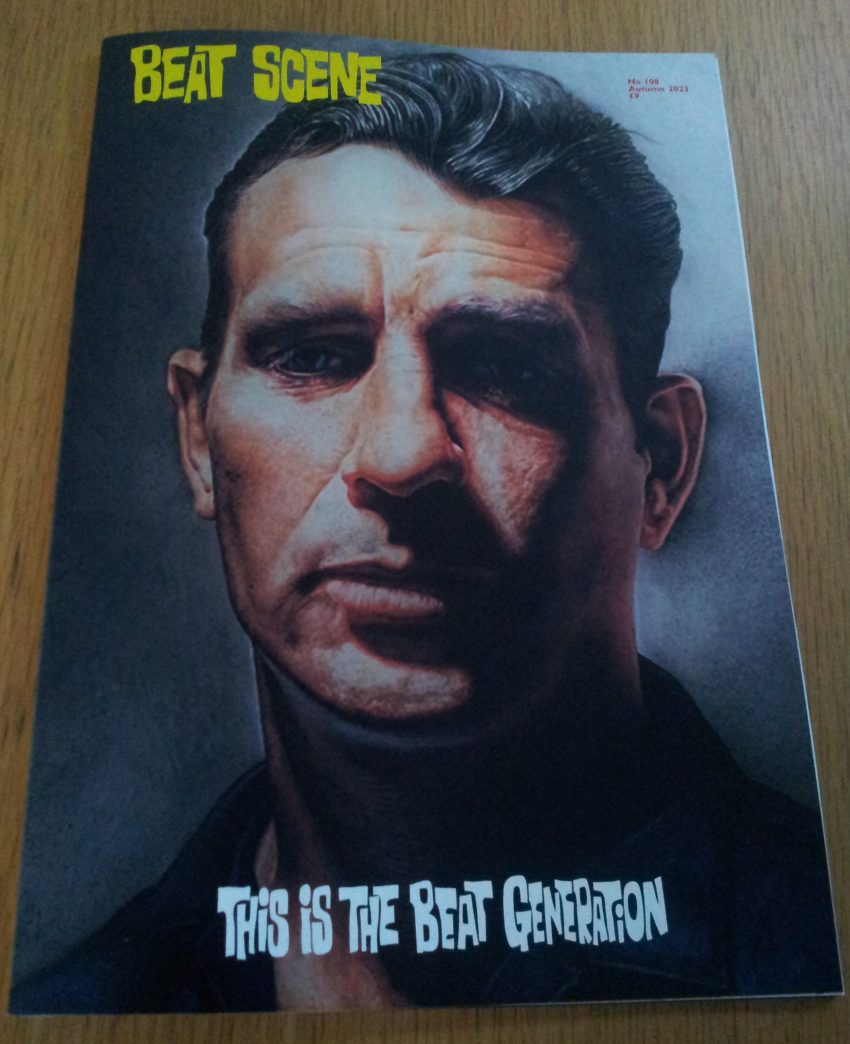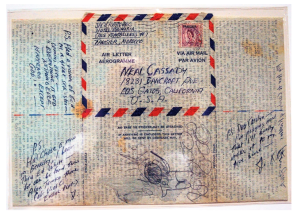 Actual letter that Jack Kerouac typed and sent to Neal Cassady on March 25, 1957. Neal and Carolyn Cassady were living at Los Gatos and Kerouac often visited them there. Looks like Jack typed his letter but added a few handwritten PS extras. His wish to move to California is clearly apparent and his disenchantment with events in NYC and the publishing establishment there. Maybe, possibly, he was despairing of On the Road ever being published? The letter is included in the second volume of Kerouac letters published by Viking and edited by Ann Charters some years ago.
Actual letter that Jack Kerouac typed and sent to Neal Cassady on March 25, 1957. Neal and Carolyn Cassady were living at Los Gatos and Kerouac often visited them there. Looks like Jack typed his letter but added a few handwritten PS extras. His wish to move to California is clearly apparent and his disenchantment with events in NYC and the publishing establishment there. Maybe, possibly, he was despairing of On the Road ever being published? The letter is included in the second volume of Kerouac letters published by Viking and edited by Ann Charters some years ago.
———————————————————————————-
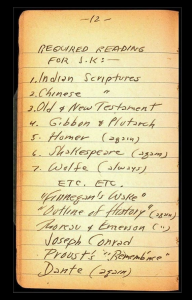
Jack Kerouac – written in his own handwriting in the late 1940s, a quick reminder to himself of what he had to read as a young man. Getting them out of some library probaly, almost certainly, maybe the Pollard in Lowell. It must have been gloomy back then, dark panelled rooms. In my memory, being in those rooms in the early to mid 1970s, it seemed very 19th century. A place where you were silenced by your surroundings. No twittering headphones allowed. Or did he travel into Boston? Doubt he rarely bought books, he had owned up to snaffling – liberating – Abbie Hoffman called it, books that he wanted to read. He still had some of those on his bookshelves around the time of his death. ‘Indian Scriptures?’ Well, he kept his word to himself didn’t he – how many of his readers have read Some of the Dharma I wonder? James Joyce – but not Ulysses – instead Finnegan’s Wake. Curious. His Catholic background still guiding him, it is a powerful force. The priests and the nuns. Heaven and Hell. Purgatory, Limbo, Venial Sin, Mortal Sin, Confession, Communion. Rosary beads. The Day of Judgement, all this and more weighing on him. Old and New Testaments on his mind. He wants to read Dante [again]. Dante’s Inferno for Jack? Don’t go there Jack, that way lies madness. Shakespeare, Joseph Conrad is about as contemporary as this list gets. He was looking back. But also closer to home with Henry David Thoreau and Ralph Waldo Emerson over in nearby Concord. Like how he says [Thomas] Wolfe and he adds ‘always.’ It seems – as he wrote his first saga of a book – that he could hear that you can’t ever go home again – in his ear and in his mind. It gave him The Town and the City, of course, in 1950. Outline of History, is that HG Wells?
————————————————————————————–
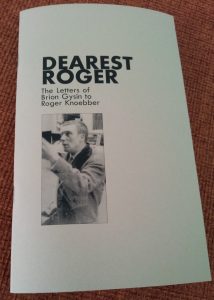
DEAREST ROGER – The Letters of Brion Gysin to Roger Knoebber – these letters span the years 1962 -1984. Intimate, revealing documents, carefully annotated by Demi Raven. 125 numbered copies in the regular Beat Scene Press chapbook series format – 8″x5″ inches. THANK YOU to all those who purchased a copy. The edition sold out very well. – There are more copies available NOW. Contact me at kevbeatscene@gmail.com
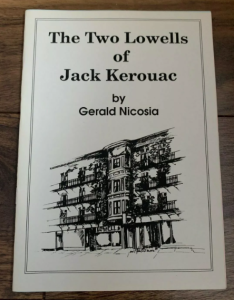
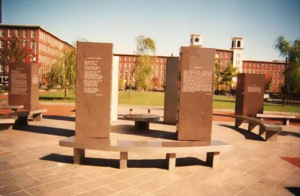
In 1988 the Jack Kerouac Park – with the big stone edifices with his words carved into them – was officially opened in his hometown of Lowell. They were and still are, impressive. Created by Texan Ben Woitena, built to withstand, I suspect, the rigours of urban existence. Durable. They put me in mind of that object that appears in that Stanley Kubrick film 2001 A Space Odyssey from over 50 years ago. Mysterious. As you might imagine the Lowell Council made an event of it. Though there had been some debate at City Hall about creating a monument to celebrate Jack Kerouac. A few saw him as a not especially good example, pointed to his drinking and suchlike. But the town’s most famous son won out. It could have been the artist Whistler or the actress Bette Davis. There was a big unveiling. Allen Ginsberg was there. Lawrence Ferlinghetti and Michael McClure too. All paying their respects. Giving readings. Michael McClure was in the company of Ray Manzarek – onetime brilliant keyboards man for The Doors of course. The duo made a string of albums together in the ensuing years. Michael McClure had a long association with the band. Those Beat poets put on a tremendous show at Lowell’s Smith Baker Center, where a huge, capacity audience sweltered in humidity, hearing Fire Engines, police sirens through the open windows [no air conditioning]. It all added to the spectacle. Lots of smaller literary events throughout the days surrounding the opening. Jack’s third wife Stella was there. Not sure how comfortable she was up on stage at the unveiling, with the poets. Writers, biographers, future biographers were all there. One was Gerald Nicosia. His biography of Jack Kerouac MEMORY BABE had been published by Grove Press in 1983. The result of six years of research, travelling around America, recording the recollections of those who knew Jack. You have to admire the tenacity. It is considered by many to be the foremost Kerouac biography. But, of course, comparisons are odious. The many Kerouac books each have their qualities. We all have our favourites. Somehow – it seemed so friendly – I met with Gerald Nicosia and heard him read a paper at an event in the week – The Two Lowells of Kerouac – and he agreed to let me publish his essay in simple chapbook form when I got back home to England. A lovely lady and local artist Janet Lambert Moore provided cover art, an empty storefront on Lowell’s main Merrimack Street. It was a fledgling Beat Scene Press publication. It sold well in those pre digital times. Word of mouth, the grapevine. A simple thing. Just one hundred copies. Gerald Nicosia explores the possibilities of Lowell in Kerouac’s mind, more akin to Doctor Sax than to the town that was struggling to reinvent itself as the mills that had driven earlier prosperity closed down. It stressed the fabulous imagination of Jack Kerouac. An impressive piece of writing. All in all it was good week in Lowell. 36 years later, does it still bring visitors to the town? I honestly don’t know. Worldwide town centres are shadows of former selves. Everywhere you look there is neglect, stagnation, rampant, greedy developments that suck the soul out of places. My own town included. Will the Kerouac monument survive – be there in a hundred years, reminding people that there was once a man who dreamed and put it all down in his Duluoz legend?
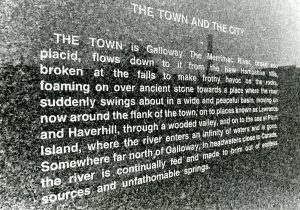
———————————————————————————–
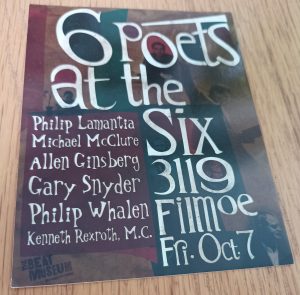
It was a postcard message from Elias Schneitter dated January 2, 2012 relating to something about Philip Lamantia. Got me thinking. Elias has a book publishing imprint – Edition BAES [https://www.edition-baes.com/] and he is behind a literature festival each year in his homeland in Austria. Many figures you might associate with the Beat Generation have been to this festival. Elias has published a good number of books, Jack Hirschman, Ruth Weiss, Neeli Cherkovski and others. Another good thing about Elias is that, like me, he is a big football fan. And like me, he supports his local team. It was a very attractive looking postcard. Issued by Gerry Cimino’s terrific Beat Museum in San Francisco. It was their retake of Allen Ginsberg’s simple invitation card to that famous, or soon to be famous, SIX GALLERY poetry reading in October 1955. Allen’s postcard, with the serious help of Philip Whalen on admin duties, was a most simple affair. Using 21st Century flair and technology the Beat Museum came up with this striking card as a modern day version. As it says on the rear of the postcard “The artwork [opposite side] is an adaptation of a flyer advertising the reading series. The deliberate misspelling of ‘Filmoe’ is faithful to the original.” It throws me a little when the museum talk of a flyer. Was there both a postcard and a flyer promoting this historic event? It’s a nice layout nevertheless. Typefaces that have a good look about them and they have the good sense to include M.C. Kenneth Rexroth at the bottom of the lineup. Cranky, grumpy, opinionated he may have been at times, but he is important in the Beat scheme of things. Without him…..You probably won’t be able to discern it, but the postcard shows Rexroth, Lamantia, Snyder, Whalen, McClure, Ginsberg in amongst the lettering on the card. To be honest, one day I hope someone will produce a similar thing with all the names of the people who were there that day. Like Jack Kerouac, Neal Cassady, John Montgomery, Lawrence Ferlinghetti. And frankly it has always amazed me that somebody, somewhere, after all these passing decades, hasn’t done the research, asked the questions to discover who was there. Probably a lot of the poets we know of, maybe a journalist or two, wives, girlfriends, potential publishers, magazine editors. Was Robert Duncan there? Shig from City Lights? Dick McBride, Jack Micheline, David Meltzer? Nancy Peters? And so on. Of course, ‘The Filmore’ in San Francisco became a beacon of musical hope in the city in the ensuing years.
The Beat Museum www.kerouac.com
———————————————————————————
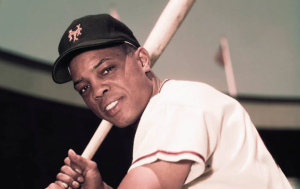 Baseball? Just like Ultravox sang many years ago – ‘It means nothing to me.’ And yet I know a little because of Jack Kerouac. A little more than I understand about American football, do they still call it ‘gridiron?’ I know because in an August 1959 article he wrote for Escapade [Vol IV, No 1] – his essays were always billed as ‘The Last Word’ – in the article he pitched off with the question ‘Who Told Willy Mays To Change His Batting Stance…?’ Now I understand Willy Mays was a legendary figure to American baseball fans and it has been relayed that he has just died aged 93. His star never dimmed. He is revered. His is to baseball what Pele is to football worldwide. Like any sports fan Kerouac has strong opinions about a sport he loves and in this light-hearted article he spouts his views on all players and aspects of baseball and the coming season. I say light-hearted, and it is, yet it has all the elements that make Kerouac a loved writer, warmth, sometimes tongue in cheek, fun, irreverent. He speaks of Ernest Hemingway, Ty Cobb, Irish Jesuits, Babe Ruth and more. He is opinionated. But it isn’t simply a throwaway article for Escapade, Kerouac was an avid sports fan. Of course, as a young guy he was a top athlete and High School football player, Columbia and all that story. Broken legs and whatnot. He was so keen on sports that he devised made up fantasy sports games and even an imaginary sports paper BASEBALL NEWS and another JACK LEWIS’S BASEBALL CHATTER. You can read all about it in a neglected Jack Kerouac book KEROUAC AT BAT: FANTASY SPORTS AND THE KING OF THE BEATS edited by Isaac Gewirtz. [Issued by The New York Public Library in 2009] – [How I hate that ‘King of the Beats’ thing – it’s so demeaning.] And it provides a close up look at Kerouac as a teenager, his powers of vivid imagination. He enthused with writer friends like Philip Whalen and Neal Cassady about baseball – see his April 1955 letter to Neal Cassady, where he is trying to build bridges with Neal – part of his talk is of Willy Mays – he is watching him on TV playing in the ‘Giants v Cubs’ game. [pages 471-472 in Jack Kerouac: Selected Letters 1940-1956 edited by Ann Charters – Viking Press] – So Mays was a constant in Kerouac’s life. I’ve just read somewhere in the many tributes – ‘Willy Mays was baseball and the world was better for it.’ No wonder Jack looked to him. This puts me in mind of Joe Di Maggio – ‘a nation turns its lonely eyes to you’ as performed by Simon and Garfunkel in their hit song Mrs. Robinson. Now another giant of American sports. Did Jack ever speak of him? Did I ever mention I once stood shoulder to shoulder with Art Garfunkel in Book City on Hollywood Boulevard for a few minutes? We were both studying the Beat Generation section. Resisted the notion of saying hello – but for days after kept humming Mrs. Robinson. Baseball, it has a lot to answer for, even to an ignoramus like me. And did Willy Mays change his batting stance I wonder?
Baseball? Just like Ultravox sang many years ago – ‘It means nothing to me.’ And yet I know a little because of Jack Kerouac. A little more than I understand about American football, do they still call it ‘gridiron?’ I know because in an August 1959 article he wrote for Escapade [Vol IV, No 1] – his essays were always billed as ‘The Last Word’ – in the article he pitched off with the question ‘Who Told Willy Mays To Change His Batting Stance…?’ Now I understand Willy Mays was a legendary figure to American baseball fans and it has been relayed that he has just died aged 93. His star never dimmed. He is revered. His is to baseball what Pele is to football worldwide. Like any sports fan Kerouac has strong opinions about a sport he loves and in this light-hearted article he spouts his views on all players and aspects of baseball and the coming season. I say light-hearted, and it is, yet it has all the elements that make Kerouac a loved writer, warmth, sometimes tongue in cheek, fun, irreverent. He speaks of Ernest Hemingway, Ty Cobb, Irish Jesuits, Babe Ruth and more. He is opinionated. But it isn’t simply a throwaway article for Escapade, Kerouac was an avid sports fan. Of course, as a young guy he was a top athlete and High School football player, Columbia and all that story. Broken legs and whatnot. He was so keen on sports that he devised made up fantasy sports games and even an imaginary sports paper BASEBALL NEWS and another JACK LEWIS’S BASEBALL CHATTER. You can read all about it in a neglected Jack Kerouac book KEROUAC AT BAT: FANTASY SPORTS AND THE KING OF THE BEATS edited by Isaac Gewirtz. [Issued by The New York Public Library in 2009] – [How I hate that ‘King of the Beats’ thing – it’s so demeaning.] And it provides a close up look at Kerouac as a teenager, his powers of vivid imagination. He enthused with writer friends like Philip Whalen and Neal Cassady about baseball – see his April 1955 letter to Neal Cassady, where he is trying to build bridges with Neal – part of his talk is of Willy Mays – he is watching him on TV playing in the ‘Giants v Cubs’ game. [pages 471-472 in Jack Kerouac: Selected Letters 1940-1956 edited by Ann Charters – Viking Press] – So Mays was a constant in Kerouac’s life. I’ve just read somewhere in the many tributes – ‘Willy Mays was baseball and the world was better for it.’ No wonder Jack looked to him. This puts me in mind of Joe Di Maggio – ‘a nation turns its lonely eyes to you’ as performed by Simon and Garfunkel in their hit song Mrs. Robinson. Now another giant of American sports. Did Jack ever speak of him? Did I ever mention I once stood shoulder to shoulder with Art Garfunkel in Book City on Hollywood Boulevard for a few minutes? We were both studying the Beat Generation section. Resisted the notion of saying hello – but for days after kept humming Mrs. Robinson. Baseball, it has a lot to answer for, even to an ignoramus like me. And did Willy Mays change his batting stance I wonder?
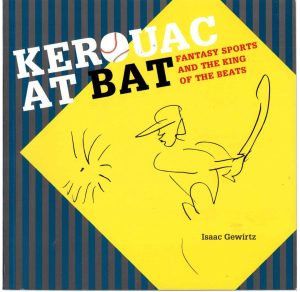
————————————————————————–
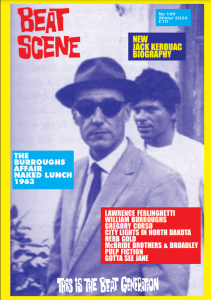 OUT NOW – Beat Scene 109 – Winter 2024. Burroughs, Diane di Prima, the Beats in North Dakota, Jack Kerouac, Gregory Corso, McBride Brothers & Broadley, Lawrence Ferlinghetti and more. Simply the Beat Generation and associated figures. The mailout is about halfway – it’s a job and a half. If you would like a copy please email kevbeatscene@gmail.com
OUT NOW – Beat Scene 109 – Winter 2024. Burroughs, Diane di Prima, the Beats in North Dakota, Jack Kerouac, Gregory Corso, McBride Brothers & Broadley, Lawrence Ferlinghetti and more. Simply the Beat Generation and associated figures. The mailout is about halfway – it’s a job and a half. If you would like a copy please email kevbeatscene@gmail.com
Something that was meant for Beat Scene 109 but space pushed it out. It is too much of a fascinating book to overlook. It has proved a very in demand publication, so you may have to search hard for it.
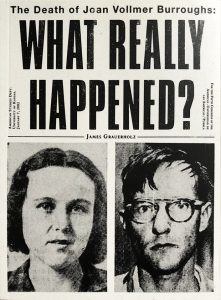
THE DEATH OF JOAN VOLLMER BURROUGHS -WHAT REALLY HAPPENED? by James Grauerholz [Moloko]
It’s buried in time now. The common law wife of William Burroughs. Mexico City. Cheap living for a man not yet a writer, that was still a while to come, in his mid thirties. Living the life in exile, mentor in his way to Allen Ginsberg and Jack Kerouac, he was some older, darker spirit. Joan, raker of trees in Louisiana in a drugged, almost zombie state. Both drinkers, druggies, detached from the everyday. Joan gets shot in the head by Burroughs in a supposed ‘William Tell’ incident, glass on head, I’ll shoot it off stupid ‘game.’ Bullet in the forehead. Now if it had been America, Burroughs would have done serious time. Others at the drunken scene scarper, vanish, lay low. Burroughs is taken in by the police. Initially, it seems, he takes responsibility for his actions, drunken or not. Once the lawyer enters the scene Burroughs is told to remain tight lipped. We likely would never have heard of him, maybe footnotes in the stories of Kerouac and Ginsberg, a little like Lucien Carr is maybe. No Doctor Benway. No Place of Dead Roads, No Naked Lunch, Salt Chunk Mary or Johnsons. Never happened. Alternative reality. But it’s Mexico in the early 1950s. Money probably changes hands. Smooth talking lawyers. Somehow William Burroughs escapes the rap. Joan dead. Burroughs, forever saddened and tainted with it all, speaks of an ‘Ugly Spirit.’ It galvanises him to write like a soul possessed. To us it’s all so horribly inexplicable. How can it be? How did he get away with it? If anyone can unravel the mystery of it all that figure may be James Grauerholz, secretary, agent, the man behind William Burroughs, a business mind as a friend and companion for decades afterwards. His influence and guidance on Burroughs cannot be overstated, steering him through distinct phases of his writer’s life.
With this handsome book by the ever impressive Moloko Press James Grauerholz leads us through it all. Does he have the answers? Read it and see. If you can find a copy.
———————————————————————————————-
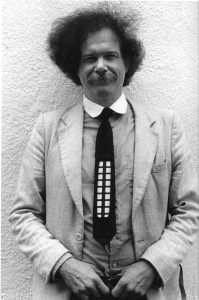
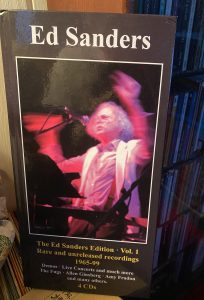 Thank you to Raymond Foye for letting me know about THE ED SANDERS EDITION Volume 1 – RARE AND UNRELEASED RECORDINGS 1965-1999. Demos, Live Concerts and much more. A 4 CD set released on the Olufsen Records label. As you will no doubt know, Ed – novelist, poet, historian (of a unique and special kind) performer on his own and with Tuli Kupferberg and The Fugs, archives and documents everything. This is a result of his attention to detail. It looks brilliant.
Thank you to Raymond Foye for letting me know about THE ED SANDERS EDITION Volume 1 – RARE AND UNRELEASED RECORDINGS 1965-1999. Demos, Live Concerts and much more. A 4 CD set released on the Olufsen Records label. As you will no doubt know, Ed – novelist, poet, historian (of a unique and special kind) performer on his own and with Tuli Kupferberg and The Fugs, archives and documents everything. This is a result of his attention to detail. It looks brilliant.
Pattismith.substack.com is a place where Patti Smith (not surprisingly) talks to her many fans on a regular basis, and interested people about what she’s been up to. Today, Sunday, March 10, she spent a brief interlude talking informally to the camera, alone in a room in her New York home, about Sylvia Plath, reading Plath’s poetry, speaking of Robert Mapplethorpe and of a photo booth picture of himself he sent to her way back. She laments his passing. She has her warm coat on and explains she’s not long come home from an exhibition of John Giorno’s work, which was held, if I didn’t mishear her, in the William Burroughs bunker. Oh, I forgot, she also mentions that the book of poetry by Sylvia Plath she reads from was bought for her by Robert Mapplethorpe in the early 1960s for $2.98. She says it was a lot of money to them back then. She seems a warm, good hearted woman. As much a writer as a musician. Have a look.. Bit of an update – pattismith.substack.com – May 19, 2024 – Patti is talking direct to camera, black and white film, curious halo of light around her in her room. She’s talking of a mini writing block, a diary kind of writing. Looking back to her youth with Robert Mapplethorpe at the Chelsea Hotel in NYC and straightening the tie of an inebriated William Burroughs, the hotel, she tells us, is full of people, artists, film makers, poets, musicians, bad art in the lobby, they are all somebody in there – [legends in their own minds?] but don’t mean a thing to anyone else? Harry Smith is mentioned. He lives there. Her writing block is solved. It is a work in progress. Little insights into her world.

———————————————————————————–
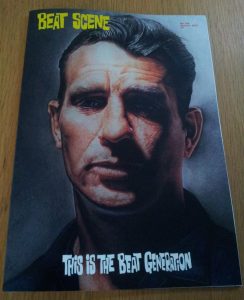
The current issue of the magazine, Beat Scene 108, has now sold out. Thanks to all subscribers and everybody who regularly pick up a copy. Without you subscribers and those who buy a copy each time it wouldn’t happen. As always, please tell your friends. Word of mouth is key. If you want a print copy, better go to Third Mind Bookshop in Ann Arbor, USA. They may help you.
—————————————————————————————————————
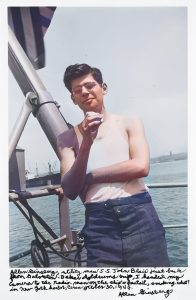 As of today, January 23, 2024, it seems an especially bleak mid winter. Dark, ferocious gales, biting cold. It seems relentless. Hibernation times. But, if you need to have a reason to emerge from that hibernation ….look no further than early to mid March at The Horse Hospital in London where there will be a string of Beat events taking place. The venue is at The Horse Hospital, Colonnade, Bloomsbury, London WC1N 1JD. You can phone or email 0207-833-3644 — popculture@thehorsehospital — Between March 7 and March 15 – there will be events centred around Allen Ginsberg (a big new book), with Barry Miles (Miles), Iain Sinclair, Peter Hale from the Allen Ginsberg Project, amongst others. Talks, conversations, displays, films, AH, SUNFLOWER, the film that took in Allen Ginsberg in London in the mid 1960s and so on. The nearest Underground Station is Russell Square. Travelling by bus – look for 7, 59, 68, 91, 168 and 188. For more go to www.thehorsehospital.com
As of today, January 23, 2024, it seems an especially bleak mid winter. Dark, ferocious gales, biting cold. It seems relentless. Hibernation times. But, if you need to have a reason to emerge from that hibernation ….look no further than early to mid March at The Horse Hospital in London where there will be a string of Beat events taking place. The venue is at The Horse Hospital, Colonnade, Bloomsbury, London WC1N 1JD. You can phone or email 0207-833-3644 — popculture@thehorsehospital — Between March 7 and March 15 – there will be events centred around Allen Ginsberg (a big new book), with Barry Miles (Miles), Iain Sinclair, Peter Hale from the Allen Ginsberg Project, amongst others. Talks, conversations, displays, films, AH, SUNFLOWER, the film that took in Allen Ginsberg in London in the mid 1960s and so on. The nearest Underground Station is Russell Square. Travelling by bus – look for 7, 59, 68, 91, 168 and 188. For more go to www.thehorsehospital.com
—————————————————————————————————
December 24. The mailout on the new issue of Beat Scene magazine has been completed. Posting contributor copies now. This is number 108. See cover here. Featuring original artwork by Jonathan Collins of Mr. Jack Kerouac. If you are unsure, Beat Scene devotes itself to all things relating to America’s ‘Beat Generation’ and associated figures. That’s the Holy Trinity of Jack Kerouac, Allen Ginsberg, William Burroughs, alongside Gregory Corso, Charles Bukowski, Philip Whalen, Diane di Prima, Joanne Kyger, Gary Snyder, Richard Brautigan, Philip Lamantia, Ken Kesey, Anne Waldman, Herbert Huncke, Lawrence Ferlinghetti, Janine Pommy Vega – see where this is going – the list is a long one. Beat Scene tries to be a print quarterly. It’s ‘perfect bound,’ that is it has a spine, like a paperback but it’s larger format. It has been published since March 1988. If you would like a copy please email me at kevbeatscene@gmail.com
A friendly and positive note from Gregory Stephenson in Denmark. Gregory says kind things about Beat Scene 108. Gregory is a writer and has a string of books to his name, many based around Beat Generation figures.
Hello Kevin,Just to say how much I enjoyed no. 108, arrived here last week. As always, many informative and interesting pieces. Your article on JK letters, the Farina article (I enjoyed his novel Been Down So Long) interesting guy, also production notes on Heart Beat. I thought Nick Nolte was well-cast in that film. But I have a prejudice in his favor. I attended a junior college (community college) in Phoenix, Arizona (Phoenix College) and Nolte attended at the same time. He was interested in the drama department of course and played roles in dramas produced by that department. He was memorable in “Inherit the Wind.” (April, 1965, strange to say, I still have the program for the play.) Very fine issue from the fine Kerouac portrait cover right through to the last page.Take care. Best, Gregory————————————————————————————–
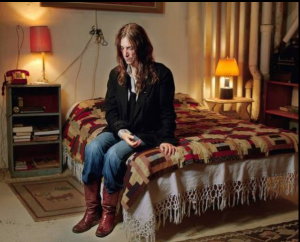 Happened upon this image of Patti Smith sitting on the bed of William Burroughs in his bunker home in New York City’s Bowery, in recent times. Not sure of the date of the photo. Burroughs seemed genuinely fond of Patti Smith (BECAUSE THE NIGHT is a favourite here), which didn’t match the much used storyline that he was anti women. Patti, for her part, seems to have genuinely been fond of Bill too. If you have time take a look at Patti’s almost daily blog and short films, where she talks of what she reads, where she’s been and suchlike. She seems a very warm human being. she’s grown on me over the years, more as a writer than a musician. Books like Auguries of Innocence and Year of the Monkey and others in recent years. She weaves her way through her travels and relaying her thoughts to the reader in a tranquil way. She’s a keen observer and aficionado of cafes. Here is a link to one of her films.
Happened upon this image of Patti Smith sitting on the bed of William Burroughs in his bunker home in New York City’s Bowery, in recent times. Not sure of the date of the photo. Burroughs seemed genuinely fond of Patti Smith (BECAUSE THE NIGHT is a favourite here), which didn’t match the much used storyline that he was anti women. Patti, for her part, seems to have genuinely been fond of Bill too. If you have time take a look at Patti’s almost daily blog and short films, where she talks of what she reads, where she’s been and suchlike. She seems a very warm human being. she’s grown on me over the years, more as a writer than a musician. Books like Auguries of Innocence and Year of the Monkey and others in recent years. She weaves her way through her travels and relaying her thoughts to the reader in a tranquil way. She’s a keen observer and aficionado of cafes. Here is a link to one of her films.
——————————————————————————————-
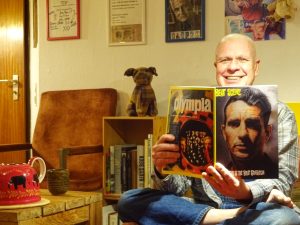 P.S. This is longtime Beat Scene subscriber Erni Baer who lives in Hamburg in Germany. He has received the new issue and kindly sent me this picture of him at home. He okayed my request to show it to you. I’d like to think that Erni’s smiling face is repeated at places around the world, from Dunstable to Alaska, as they get Beat Scene through their letter box.
P.S. This is longtime Beat Scene subscriber Erni Baer who lives in Hamburg in Germany. He has received the new issue and kindly sent me this picture of him at home. He okayed my request to show it to you. I’d like to think that Erni’s smiling face is repeated at places around the world, from Dunstable to Alaska, as they get Beat Scene through their letter box.
———————————————————————————————————
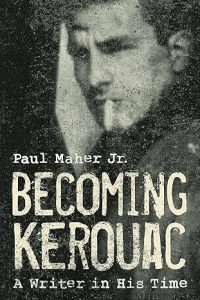 A new book has been keeping me off street corners just recently. BECOMING KEROUAC: A WRITER IN HIS TIME is written by American author Paul Maher Jr. Published by Lyon Press, it is due to be officially released in January 2024. I’ve just finished reading Paul’s book and I’d have to say it kind of rocks me back on my heels just a little. Paul Maher is no stranger to books on Jack Kerouac, for a good number of years he has published a string of titles examining phases and aspects of Kerouac’s life and writing. He’s perhaps not so well known in England as some of the other biographers, that’s down, largely perhaps, to distribution of his books in this country. As I understand it he did for a time live in or near to Kerouac’s hometown of Lowell in Massachusetts. So he has a feel for the places Kerouac wrote of. I’ve admired his books, they are big major works, the detail is impressive always. I’m hoping this new hardcover will reach many more in this country, this time around. It is on sale – pre-order – at many major outlets. What I like about Maher’s Kerouac books, and this new one is no exception, is that he provides – what would you call it? — a back story. There’s a wider context to Kerouac’s times, a literary & sociological backdrop where the reader gets told some of the factors that impinge on Kerouac. Kind of cause and effect. This young Kerouac may surprise long time readers of the man. It has me. Tortured seems a fitting description of Kerouac’s life right up to 1957. Paul Maher is unflinching in his telling of the tale. Often it isn’t pretty. What did William Burroughs say, when asked about Jack? ‘Kerouac, oh he’s a writer.’ This was it. Jack almost abandons being a published writer simply to write purely for his own joy, to get it down, record it all, every last twinkling star, every day of regret and remorse. Paul Maher relays the joy, sadness, despair, relief, false starts, the indifference of a New York publishing scene. Paul Maher probably swore on a bible to tell the truth, the whole truth and nothing but the Jack Kerouac truth.
A new book has been keeping me off street corners just recently. BECOMING KEROUAC: A WRITER IN HIS TIME is written by American author Paul Maher Jr. Published by Lyon Press, it is due to be officially released in January 2024. I’ve just finished reading Paul’s book and I’d have to say it kind of rocks me back on my heels just a little. Paul Maher is no stranger to books on Jack Kerouac, for a good number of years he has published a string of titles examining phases and aspects of Kerouac’s life and writing. He’s perhaps not so well known in England as some of the other biographers, that’s down, largely perhaps, to distribution of his books in this country. As I understand it he did for a time live in or near to Kerouac’s hometown of Lowell in Massachusetts. So he has a feel for the places Kerouac wrote of. I’ve admired his books, they are big major works, the detail is impressive always. I’m hoping this new hardcover will reach many more in this country, this time around. It is on sale – pre-order – at many major outlets. What I like about Maher’s Kerouac books, and this new one is no exception, is that he provides – what would you call it? — a back story. There’s a wider context to Kerouac’s times, a literary & sociological backdrop where the reader gets told some of the factors that impinge on Kerouac. Kind of cause and effect. This young Kerouac may surprise long time readers of the man. It has me. Tortured seems a fitting description of Kerouac’s life right up to 1957. Paul Maher is unflinching in his telling of the tale. Often it isn’t pretty. What did William Burroughs say, when asked about Jack? ‘Kerouac, oh he’s a writer.’ This was it. Jack almost abandons being a published writer simply to write purely for his own joy, to get it down, record it all, every last twinkling star, every day of regret and remorse. Paul Maher relays the joy, sadness, despair, relief, false starts, the indifference of a New York publishing scene. Paul Maher probably swore on a bible to tell the truth, the whole truth and nothing but the Jack Kerouac truth.
——————————————————————————————–
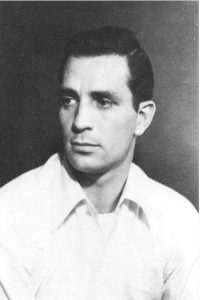 When Jack Kerouac died in October 1969 at the age of just 47 he was something of a mostly overlooked literary figure. In truth he had alienated many of his readers with drunken appearances on shows like William Buckley’s Firing Line – a 1968 appearance that saw him dismiss Allen Ginsberg with a wave of his hand – Allen, whom the studio camera captured in the audience – the show was live – must have been deeply hurt, but his face remained stoically calm. By 1969 Kerouac was largely ignored by the American book buying public, 1957 seemed a very long time ago – but there were those who stayed steadfast in their admiration for his writing and saw past his daily drunkenness and bluster. One of those was his very first biographer Ann Charters (though I maintain that Ann tied in a dead heat with Charles Jarvis, a Lowell teacher who knew Kerouac personally) – the Jarvis biography – often forgotten these days – also appeared in 1973. However at the time of Jack Kerouac’s death Ann Charters, a staunch supporter, felt the need to do something quickly to remind people of his writing talents and so in 1969 – through her Portents Press published Jack Kerouac’s HUGO WEBER as a broadside. There were only two hundred published and in some ways was one of the last Kerouac items to be published for the next few years, the Kerouac doors to his archives being firmly shut by Stella Sampas, his third wife. There were times, it is reported, when Jack could have been better with Stella, but for all his faults she loved him. I saw at close quarters the depth of her emotions at the very first ‘official’ Lowell Jack Kerouac event in an empty small store nearly 45 years ago, as she sobbed when hearing Jack reading NEAL AND THE THREE STOOGES. You might have heard a pin drop. An audience of maybe eighty people, largely from Lowell and environs I suspect, Mary King, Dean Contover, Charlie Garguilio and a couple of his pals, Pat Pestana, Henry Hefco, Paul Marion, maybe Brian Dean, Jay Prendergast and others. There is a copy of that Jack Kerouac broadside on the table here now. Maybe it was the last before the doors were locked for a few years while Stella grieved – the world had largely turned its back on Jack Kerouac, that’s including the literary world, he struggled to get anything published. Why should Stella care. Confusingly Kerouac has subtitled his poem – An Imaginary Portrait of Ullysses S. Grant & Edgar Allen Poe. Jack, ever one for fun, brings comedian Red Skelton, Rimbaud, Boris Karloff, Bela Lugosi, Nosferatu into the equation. As he said once – ‘I’m just having a little fun mother.’
When Jack Kerouac died in October 1969 at the age of just 47 he was something of a mostly overlooked literary figure. In truth he had alienated many of his readers with drunken appearances on shows like William Buckley’s Firing Line – a 1968 appearance that saw him dismiss Allen Ginsberg with a wave of his hand – Allen, whom the studio camera captured in the audience – the show was live – must have been deeply hurt, but his face remained stoically calm. By 1969 Kerouac was largely ignored by the American book buying public, 1957 seemed a very long time ago – but there were those who stayed steadfast in their admiration for his writing and saw past his daily drunkenness and bluster. One of those was his very first biographer Ann Charters (though I maintain that Ann tied in a dead heat with Charles Jarvis, a Lowell teacher who knew Kerouac personally) – the Jarvis biography – often forgotten these days – also appeared in 1973. However at the time of Jack Kerouac’s death Ann Charters, a staunch supporter, felt the need to do something quickly to remind people of his writing talents and so in 1969 – through her Portents Press published Jack Kerouac’s HUGO WEBER as a broadside. There were only two hundred published and in some ways was one of the last Kerouac items to be published for the next few years, the Kerouac doors to his archives being firmly shut by Stella Sampas, his third wife. There were times, it is reported, when Jack could have been better with Stella, but for all his faults she loved him. I saw at close quarters the depth of her emotions at the very first ‘official’ Lowell Jack Kerouac event in an empty small store nearly 45 years ago, as she sobbed when hearing Jack reading NEAL AND THE THREE STOOGES. You might have heard a pin drop. An audience of maybe eighty people, largely from Lowell and environs I suspect, Mary King, Dean Contover, Charlie Garguilio and a couple of his pals, Pat Pestana, Henry Hefco, Paul Marion, maybe Brian Dean, Jay Prendergast and others. There is a copy of that Jack Kerouac broadside on the table here now. Maybe it was the last before the doors were locked for a few years while Stella grieved – the world had largely turned its back on Jack Kerouac, that’s including the literary world, he struggled to get anything published. Why should Stella care. Confusingly Kerouac has subtitled his poem – An Imaginary Portrait of Ullysses S. Grant & Edgar Allen Poe. Jack, ever one for fun, brings comedian Red Skelton, Rimbaud, Boris Karloff, Bela Lugosi, Nosferatu into the equation. As he said once – ‘I’m just having a little fun mother.’
————————————————————————————————————
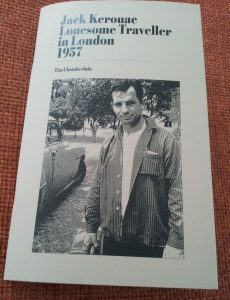
Thanks to the small band of Beat readers and fans who ordered the upcoming chapbook – JACK KEROUAC: LONESOME TRAVELLER IN LONDON – 1957. Your interest is really appreciated. The author – Tim Chamberlain – is English and studies Jack Kerouac’s visit to London from that distinct English perspective. He knows the history of it all. His essay had me returning to passages in Kerouac’s works where he writes of being here in England. He often read writers such as John Galsworthy and Radcliffe Hall in his younger days. And in letters, especially to his big New York friend John Clellon Holmes, would write of his visions of England, how he saw it, envisioned it. Possibly based on films he had seen. Why England sometimes cropped up in his poems. There’s one letter to Holmes where he describes himself coming out of the – as he terms it – ‘Rub a Dub’ pub and cycling across the moor to his lonely writer’s retreat cottage. You can’t help but be drawn in by his idealistic innocent visions of this green and pleasant land. Perhaps encountering Sherlock Holmes and Doctor Watson on the trail of that hound on the moor in the mist. The issue will be going to the printer later today – Tuesday, August 29 – and should be ready in around a week. Anyone interested contact me – Kevin Ring – at kevbeatscene@gmail.com
——————————————————————————————–
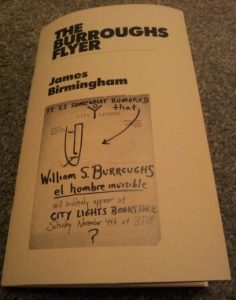 This rough and crude flyer intrigued when it appeared on the net recently. Got me wondering if El Hombre Invisible did in fact turn up? No year is given, but November 4 at 3 p.m. gives something of a clue. Burroughs was never, in my memory of him, ever in San Francisco very much at all. And initially it seemed to me he’d had little contact with Lawrence Ferlingetti’s outfit, of course a few well know books, The Yage Letters, The Burroughs File and Roosevelt After Inauguration – those three spring readily to mind. On closer inspection you can add – his inclusion in Journal For The Protection of All Beings – No 1 issue. Then there was Nova Broadcast in 1963, City Lights Journal No 1 included a Burroughs contribution, APO 33 Bulletin was another in the early 1960s. The City Lights/Beach Books document alongside Mary Beach and Claude Pelieu in the mid 1960s and another, quirkily titled With Revolvers Aimed (though possibly quite apt given the Burroughs fascination with guns). And finally So Who Owns Death TV? If you come up with any other obscurities from City Lights and William Burroughs, do let me know. But none of this answers the question of whether he turned up at City Lights on November 4 of which year? Some quick research tells me that Saturday November 4 happened in 1961, again in 1967, 1972, a big gap then to 1989. Looking at where Burroughs was at these times, it seems highly unlikely he was in North Beach. 1989 around November 4 he was writing to Brion Gysin from London. Back in 1961 he was corresponding with Norman Mailer from London around November time. Elsewhere it appears he was a long way from California around these specific November 4 dates. Maybe it is a fools errand, but more research required. There may be clues in the handwriting on the flyer? Shig’s, Dick McBride, Nancy Peters? 1978 seems a possibility. But Burroughs was in Europe in the late months of that year and then came The Nova Convention. So, maybe, the flyer is simply a wind up to bring the crowds in? But wait, is that the cavalry hooves I hear pounding up the road? Mr. Larry Romano, late of Vermont, has pitched in with some pointers. More soon.
This rough and crude flyer intrigued when it appeared on the net recently. Got me wondering if El Hombre Invisible did in fact turn up? No year is given, but November 4 at 3 p.m. gives something of a clue. Burroughs was never, in my memory of him, ever in San Francisco very much at all. And initially it seemed to me he’d had little contact with Lawrence Ferlingetti’s outfit, of course a few well know books, The Yage Letters, The Burroughs File and Roosevelt After Inauguration – those three spring readily to mind. On closer inspection you can add – his inclusion in Journal For The Protection of All Beings – No 1 issue. Then there was Nova Broadcast in 1963, City Lights Journal No 1 included a Burroughs contribution, APO 33 Bulletin was another in the early 1960s. The City Lights/Beach Books document alongside Mary Beach and Claude Pelieu in the mid 1960s and another, quirkily titled With Revolvers Aimed (though possibly quite apt given the Burroughs fascination with guns). And finally So Who Owns Death TV? If you come up with any other obscurities from City Lights and William Burroughs, do let me know. But none of this answers the question of whether he turned up at City Lights on November 4 of which year? Some quick research tells me that Saturday November 4 happened in 1961, again in 1967, 1972, a big gap then to 1989. Looking at where Burroughs was at these times, it seems highly unlikely he was in North Beach. 1989 around November 4 he was writing to Brion Gysin from London. Back in 1961 he was corresponding with Norman Mailer from London around November time. Elsewhere it appears he was a long way from California around these specific November 4 dates. Maybe it is a fools errand, but more research required. There may be clues in the handwriting on the flyer? Shig’s, Dick McBride, Nancy Peters? 1978 seems a possibility. But Burroughs was in Europe in the late months of that year and then came The Nova Convention. So, maybe, the flyer is simply a wind up to bring the crowds in? But wait, is that the cavalry hooves I hear pounding up the road? Mr. Larry Romano, late of Vermont, has pitched in with some pointers. More soon.
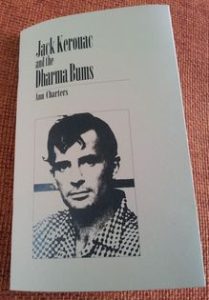 Out NOW. Jack Kerouac and the Dharma Bums. Thanks to Ann Charters for kind permission to publish this and make it the latest in the Beat Scene Press chapbook series, almost 80 issues now. Quite a number of Jack Kerouac commentators have commented over the years that the brief interlude that was ‘The Dharma Bums’ period was, arguably, the happiest time in Jack Kerouac’s life. Spending time in San Francisco, Berkeley, that Mill Valley area with Gary Snyder, Allen Ginsberg, Philip Whalen and the others. Little shacks, poetry readings, people on Jack’s wavelength, bursts of creativity from them all. So Ann Charters, who was in that phase, observing, taking it in, on the spot, going on a night out with Peter Orlovsky, living almost as simply as Kerouac and Snyder in their tiny abodes. I’ll have copies in days. If you would like a copy email me at kevbeatscene@gmail.com
Out NOW. Jack Kerouac and the Dharma Bums. Thanks to Ann Charters for kind permission to publish this and make it the latest in the Beat Scene Press chapbook series, almost 80 issues now. Quite a number of Jack Kerouac commentators have commented over the years that the brief interlude that was ‘The Dharma Bums’ period was, arguably, the happiest time in Jack Kerouac’s life. Spending time in San Francisco, Berkeley, that Mill Valley area with Gary Snyder, Allen Ginsberg, Philip Whalen and the others. Little shacks, poetry readings, people on Jack’s wavelength, bursts of creativity from them all. So Ann Charters, who was in that phase, observing, taking it in, on the spot, going on a night out with Peter Orlovsky, living almost as simply as Kerouac and Snyder in their tiny abodes. I’ll have copies in days. If you would like a copy email me at kevbeatscene@gmail.com
————————————————————————————————————–
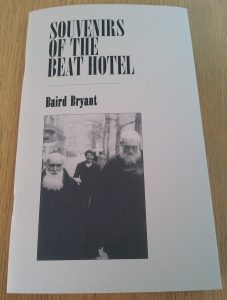 There is a new Beat Scene chapbook – SOUVENIRS OF THE BEAT HOTEL by Baird Bryant. Number 77 in the series. It’s in the regular format of 8″x5″ – 125 numbered copies. Bryant was a film man on the 1969 film EASY RIDER, featuring Dennis Hopper, Peter Fonda and a young Jack Nicholson. He lived in the Beat Hotel in Paris alongside Burroughs, Corso, Ginsberg and others. Alex Trocchi was another he counted as a Parisian pal. These are some of his memories of those times. If you would like a copy please contact me at kevbeatscene@gmail.com
There is a new Beat Scene chapbook – SOUVENIRS OF THE BEAT HOTEL by Baird Bryant. Number 77 in the series. It’s in the regular format of 8″x5″ – 125 numbered copies. Bryant was a film man on the 1969 film EASY RIDER, featuring Dennis Hopper, Peter Fonda and a young Jack Nicholson. He lived in the Beat Hotel in Paris alongside Burroughs, Corso, Ginsberg and others. Alex Trocchi was another he counted as a Parisian pal. These are some of his memories of those times. If you would like a copy please contact me at kevbeatscene@gmail.com
———————————————————————————————————————
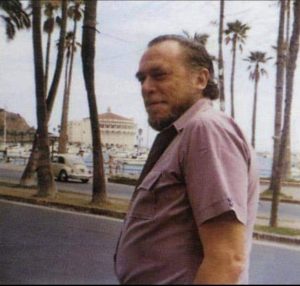 There is a new Beat Scene Press chapbook. This is Charles Bukowski: End Of An Era by yours truly. It is number 76 in this series. It is an extended essay that looks back at 1968 and a particular letter typed to Jon and Louise Webb who, together, ran the Loujon Press. A lot of the time from their home in New Orleans and later in Arizona. The chapbook is in the regular format – 8″x5″ inches. 125 numbered copies. If you would like to get hold of a copy email kevbeatscene@gmail.com
There is a new Beat Scene Press chapbook. This is Charles Bukowski: End Of An Era by yours truly. It is number 76 in this series. It is an extended essay that looks back at 1968 and a particular letter typed to Jon and Louise Webb who, together, ran the Loujon Press. A lot of the time from their home in New Orleans and later in Arizona. The chapbook is in the regular format – 8″x5″ inches. 125 numbered copies. If you would like to get hold of a copy email kevbeatscene@gmail.com
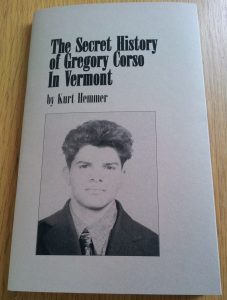 There is a new Beat Scene Press chapbook, the first in a very long time. THE SECRET HISTORY OF GREGORY CORSO IN VERMONT by Kurt Hemmer is number 75 in the series. In an edition of 125 numbered copies. If interested in getting a copy please email kevbeatscene@gmail.com for further information.
There is a new Beat Scene Press chapbook, the first in a very long time. THE SECRET HISTORY OF GREGORY CORSO IN VERMONT by Kurt Hemmer is number 75 in the series. In an edition of 125 numbered copies. If interested in getting a copy please email kevbeatscene@gmail.com for further information.
———————————————————————————————————————-
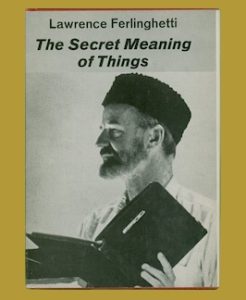 Colin Still is a modest man. For years he has filmed and recorded figures of the Beat Generation and lots of associated figures. It is just a facet of what he does. He has a site and here is a link to that grand old man of American poetry, Lawrence Ferlinghetti, who lived to be 102, reading a poem I was lucky enough to receive in a letter from him many years ago. https://www.opticnerve.co.uk/poetry/american-poets/lawrence-ferlinghetti/history-of-the-airplane —- Ferlinghetti should be on every syllabus in every higher education establishment around the globe. I know he is taught in some places. Colin Still has much film of Ferlinghetti, Robert Creeley, Allen Ginsberg and many others. Have a look.
Colin Still is a modest man. For years he has filmed and recorded figures of the Beat Generation and lots of associated figures. It is just a facet of what he does. He has a site and here is a link to that grand old man of American poetry, Lawrence Ferlinghetti, who lived to be 102, reading a poem I was lucky enough to receive in a letter from him many years ago. https://www.opticnerve.co.uk/poetry/american-poets/lawrence-ferlinghetti/history-of-the-airplane —- Ferlinghetti should be on every syllabus in every higher education establishment around the globe. I know he is taught in some places. Colin Still has much film of Ferlinghetti, Robert Creeley, Allen Ginsberg and many others. Have a look.
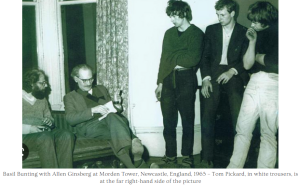
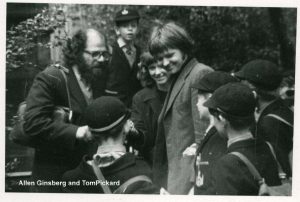
Life is so unlikely at times. Couldn’t sleep. It was 4 a.m. Began reading an eight year old copy of the English music magazine Mojo. Drawn in by a lengthy interview with Jerry Dammers, the original founder of Coventry’s The Specials. A long article about the early days of Fairport Convention and, in particular, Sandy Denny. An interview with Mark Knopfler revealed something I didn’t know, the fact that he worked on Newcastle’s Evening Chronicle newspaper as a very young man in the 1960s and he recalled taking note of Basil Bunting, the Northeast poet who worked on the newspaper back then – there was a song on Knopfler’s new 2015 album, called BASIL – Mojo describes it as “…distant remembered time, before the world changed, shimmering, dreamlike Basil..” – well let Mark Knopfler tell you – “I started there at 14, but I was 15 when I started asking about him. He was a man out of time, very interested in time. As well as a meditation on time [Bunting’s epic poem] Briggflatts was an exploration of young love wasted. I had no clue he was part of any of that. When you’re 15 you’re so full of yourself and your future. Of course, now I sort of find myself far more in sympathy with Basil.” Allen Ginsberg championed and rated Basil Bunting highly. Lawrence Ferlinghetti and Gregory Corso, Ginsberg himself, all travelled to Newcastle’s Morden Tower to read with him. I knew Morden Tower well, used to go there whilst living and studying in Newcastle in the mid 1970s. Reading about it in Mojo was such a surprise and from Mark Knopfler too. That’s the older Basil Bunting larking about with Allen Ginsberg – above. And another of Allen Ginsberg with Tom Pickard. Tom, another very North East in England poet who initiated the poetry readings in Newcastle at Morden Tower, where a whole line of Beat poets read over time. Tom played a significant role in the rise again of Basil Bunting.
———————————————————————————————
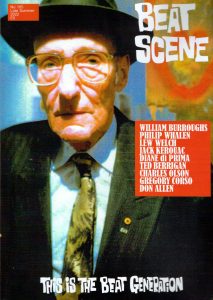 There is a new issue of Beat Scene magazine. Number 105. If you don’t know about it – Beat Scene is a long running print quarterly. Devoted to America’s Beat Generation. That’s Jack Kerouac, William Burroughs, Allen Ginsberg, Neal Cassady, Gary Snyder, Lawrence Ferlinghetti and many others. Original essays, material from the archives, often the more obscure history of these people, sometimes even examples of their work, photos and so on. Perfect bound, it has a spine. The Beat Generation in one publication. All subscriber copies of this issue have now been mailed. Most in the UK should have their copy by now or shortly. In Europe you may have your copy or soon will. USA, Australia, Japan etc you’ll be seeing it soon. Thank you to all you subscribers, some of whom have been there since issue One back in 1988, you are all are keeping it alive. If you are interested and want to know more email me at kevbeatscene@gmail.com
There is a new issue of Beat Scene magazine. Number 105. If you don’t know about it – Beat Scene is a long running print quarterly. Devoted to America’s Beat Generation. That’s Jack Kerouac, William Burroughs, Allen Ginsberg, Neal Cassady, Gary Snyder, Lawrence Ferlinghetti and many others. Original essays, material from the archives, often the more obscure history of these people, sometimes even examples of their work, photos and so on. Perfect bound, it has a spine. The Beat Generation in one publication. All subscriber copies of this issue have now been mailed. Most in the UK should have their copy by now or shortly. In Europe you may have your copy or soon will. USA, Australia, Japan etc you’ll be seeing it soon. Thank you to all you subscribers, some of whom have been there since issue One back in 1988, you are all are keeping it alive. If you are interested and want to know more email me at kevbeatscene@gmail.com
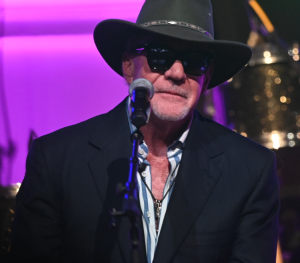
Many will recognise the name Jim Irsay. The guy who famously spent millions of dollars buying the original scroll version of Jack Kerouac’s On the Road novel a number of years ago. Irsay, a wealthy man, treasures latter day cultural artifacts, such as Bob Dylan’s 1965 Newport electric guitar, Abe Lincoln’s walking stick, Grateful Dead items, Hunter S. Thompson’s car, Muhammed Ali’s world title belt etc. Mr. Irsay is not your average capitalist businessman it seems. Here’s a very recent interview with him. Thanks to Jerry Cimino of the Beat Museum in San Francisco for bringing it to my attention.The interview is by Brandon Wenerd and appears on a site called BroBible. https://brobible.com/culture/article/jim-irsay-on-collecting-guitars-the-grateful-dead-and-hunter-s-thompson/?mc_cid=3013f2c45f&mc_eid=fcdbf1a2e6
—————————————————————————————
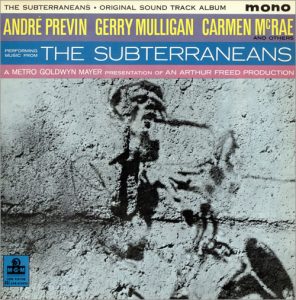
A long time ago I managed to see the filmed adaptation of Jack Kerouac’s novel THE SUBTERRANEANS. To say it was a complete let down, a total, baffling, disappointment would be a major understatement. It is a travesty of a film. Of course one of its glaring faults is that Leslie Caron, a leading actress of those times and very white, acted the part of ‘Mardou’ in the movie. Kerouac’s ‘Mardou’ was a black woman. The film company bowed to Hollywood industry racism of the times and in one awful move destroyed the film. It was a bad movie anyway, they took the essence of Kerouac’s book, threw it away and replaced it with all the ‘Beatnik’ hype and jargon they could throw at it. Tom and Jerry would have done a better job. Kerouac, in the film, became an Olympic bound swimmer. I watched it, not believing my eyes. Somehow I got given the film on a Colab reel, the type that would have gone around USA cinemas back then, Bute, Montana one week, Klamath Falls the next, that kind of thing. Heavens knows what audiences, probably many of them keen to know more about Jack Kerouac – in towns across America – made of it. Some warped, cartoon version of the Beat Generation is what they got. George Peppard, a future member of ‘The A – Team’ as Kerouac. I guess the reel is a little piece of US movie history, Beat ephemera. All that’s required is a hick American town cinema and it can be the last picture show all over again.
———————————————————————————————————–
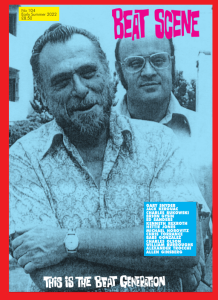
Out now – BEAT SCENE 104. This is the current issue of the magazine. So, if you want a copy, don’t delay. It’s back to an eclectic mix for this one. Charles Olson features, as do Brion Gysin and William Burroughs, Charles Bukowski. Somebody called Jack Kerouac is having a runout in there, Alexander Trocchi and Michael Horovitz and more besides. If you do want to secure yourself a copy, email me at kevbeatscene@gmail.com
—————————————————————————————————————–
WHAT’S LEFT OF KEROUAC? BBC RADIO 4
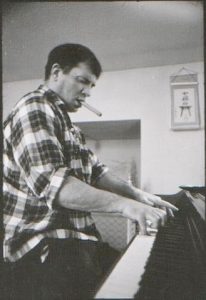
You may have heard this very recent half hour show on BBC Radio 4? Produced to play a part in the 100th birthdate of Jack Kerouac, who was born in a modest house on a quiet street in the medium sized town of Lowell in Massachusetts in March 1922. It revived my own dormant memories of the town, but I wanted to explore here some of the themes opened up by the presenters A. M. Homes, Holly George-Warren and Englishman Geoff Dyer who has been domiciled in California for many years. Let me first say they all seemed utterly genuine and well intentioned. All of them said thoughtful things, saying it as they saw it. It was reassuring when one of Warren and Home, I’m not sure which – spoke of how they liked The Lowell Sun Building. How it lit up in the dark. I always liked that too. Lowell needed it. Some illumination. Geoff Dyer struck a chord when he said Kerouac was ‘trying to get back something he’d lost.’ Isn’t that so true of the human condition? So glad they were able to incorporate Jack’s interview with his NY friend Ben Hecht. They knew each other so Jack was relaxed in his company and Hecht drew out Jack’s fascination with the spiritual. Geoff Dyer said Jack was a romantic writer – not in a hearts and flowers way – more seeing the poetry of life, where the spirit soars. He also rightly stressed that Jack’s was ‘…a turbulent and contested reputation.’ He’s spot on. Dyer was a welcome English accent. I’ve not heard of him previously. Holly George-Warren is familiar to me through the ROLLING STONE BOOK OF THE BEATS. She’s embarking on the writing of the next biography of Kerouac. It worried me that Kerouac’s ‘Queerness’ was thrown into the mix, quite unexpectedly. I’m sure they meant in a wider, fuller sense, that he was an outsider for his times, the later 1940s and onwards. It might turn into something like appropriation I’m thinking. It would seriously diminish him. To measure him by the norms, the attitudes of now. Totally unjust. Just not right. Where his sexuality is the yardstick. Surely it’s Jack Kerouac as WRITER. That’s all he ever wanted. Read what he wrote, in his books and letters. Anything else is subjecting him to that ‘celebrity’ focus he suffered after the publication of On the Road in 1957. That killed him. Going down that same path all over again, well…..
Interspersed were comments from Lowell locals, where the show was recorded. Some of their comments echoed what I recalled of the town. ‘Jack who?’ being a regular response. Somewhere along the line A.M. Homes said something along the lines of ‘Lowell was the broken heart of the country.’ The dereliction of the textile mills that employed so many in the town, their partial restoration and I thought of Kerouac’s broken heart as well. For that’s what it was. I felt there was too much emphasis on On the Road. As there always is in any show about Kerouac. As a little aside here – I this week read Tom Waits in a music magazine interview talking a little about Kerouac’s late brief novel PIC. And pumped the air. Good on you Tom. Sure it may raise the fur a little, but you have to see the wider picture, the context. Worrying was how promoting Kerouac seemed to be hand in glove with the tourist aspect of the town. Now I’m sure Jack would like to help the town anyway but it all seemed so corporate. To offset that feeling there was nice jazz. Used in countless other Kerouac radio shows, well because it’s so poignant and so good.
It all took me back to the what I’ve always understood to have been the very first planned, organised Kerouac event in Lowell on Saturday, October 17, 1981. I was in Lowell – had been there a few days. I kind of knew my way around town a little having been a regular visitor since the early 1970s on first discovering the works of Jack Kerouac. Early visits to the town had often elicited the reply ‘Jack who?’ when feeling my way around the town. Only when encountering the likes of Jay McHale, Martha Mayo, Rob McLeod, Jay Pendergast, Brian Dean and others did it become evident that there was a nucleus of Kerouac devotees there, carrying the torch through the doldrum years. Now, in 1981 there was a fresh group of young faces who rated Kerouac. Charlie Gargiulio, Paul Marion, Pat, Julie, Henry, Dean, Mary, Dick and Jean and others. All decent good people I was pleased to call friends. They were all there on this Saturday night at the event in what I was told was the Arts Alive building on Merrimack Street in the centre of Lowell. It was an empty store. There were maybe a hundred people there. Fans, the curious. Jack Kerouac’s third wife Stella was there. Perhaps the highlight of the evening, it ran for two or three hours, was a playing of NEAL AND THE THREE STOOGES, a livewire reading by Jack. You could hear a pin drop as the tape wound on. Remember this was well before the internet. People had mostly never heard Jack’s voice before. I’d heard a few bootleg cassettes, but that was it. In the midst of this reading Stella started quietly sobbing, trying to stifle her tears as best she could. Maybe it was my imagination but you could feel the empathy for her. And shortly after events came to a close. A lot of us went to the Old Worthern bar up the street. The night went into the wee small hours. The event seemed almost spontaneous and just a lot of people gathering because Jack Kerouac, the local guy made good, was one of them and to varying degrees they smiled when they heard his name, picked up one of his books. It was all about Jack. From here, now, it seems that the modern day Jack Kerouac yearly celebration, running over days, has, to an extent, lost its focus somewhat. The bus tours and the like.
‘I’ve never voted,’ Jack Kerouac tells Ben Hecht in WHAT’S LEFT OF KEROUAC? – it was a sign that he wasn’t interested in the corporate world – ‘reality’ that most of us get pulled into. He was an outsider and happy with that. Thinking back to the first time in Lowell in those early 1970s – it took me back to standing outside 9 Lupine Road, it was early in a sunny morning. We were staring at the house for a few quiet minutes, hoping somebody wasn’t calling the police. A young girl stepped out, maybe twenty years old. She was curious to know what we were doing, but friendly with it. I stammered something about Kerouac. She had heard vaguely of him I remember but had no idea he had been born here. It stunned me. She asked if I knew The Beatles. She seemed sincere about it. I liked that innocence. The street was deserted. It was very much Jack who? Part of me wanted it to stay that way.
——————————————————————————————————-
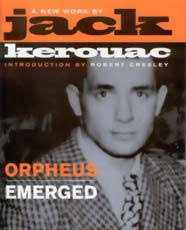
KEROUAC’S MUSIC OF THE YEARS GONE BY
(with thanks to Hoagy Carmichael and the peerless Nat King Cole)
So, Jack Kerouac, you would have been a hundred years old today. Instead you have been safe in Heaven dead since October 1969. A few people have sent me emails and even a couple of letters, all arriving today. You seem to have impacted on people’s lives far beyond the reach of the average writer. You’ve gotten into their emotions. Sure your spontaneous rush of writing impresses them, that first thought, best sort kind of thing. But once they stretch past that they saw your humanity, warmth, compassion, your innate belief that life, for all of us could be….so different with a little extra thought. With some humility, humbleness, that, well I think of your compassion again, that you espoused in all those words of yours. Your Buddhism, your Catholicism, your religiosity and you barely had time for ‘organised faith’ – it was all a gut reaction. You didn’t need no church. You wanted to see the face of God -and now maybe, hopefully, you have and whatever is there in that great mystery of life and death, ‘God’ has shown you compassion and it isn’t all just that terrifying void that you sometimes spoke of. Who knows? We have to die to find out. Unless you closed your eyes one last time and that was it. No soul to Heaven. Us down here, we just don’t know. But your tragedy for us, and a few of those emails and letters here today, Saturday March 12, speak of this, this tragedy of your life, all those years past age 47 for you – you could have carried on. Gone to AA meetings, cleaned up. Written 50 more books. Told the world you still wanted to see the face of God, but were prepared to wait a decade or three more to do just that. Someone wrote to me just now, very astutely I thought, what if your On the Road had been reviewed by the regular New York Times guy instead of sympathetic Gilbert Millstein and he’d panned it, given you some more time before you were pushed into that white hot media glare as the ‘King of the Beats?’ You might have stumbled on a year or two more in semi obscurity? Quite a perceptive thought. Thanks Dan. So, for now, today, as I said in the ‘First Words’ of the new Beat Scene – we think of Jack Kerouac…we think of Jack Kerouac. What might have been. But what is, also.
——————————————————————————————————————
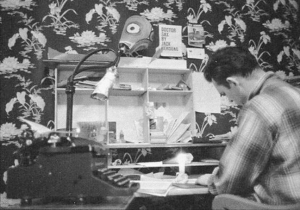 It’s easy to imagine this is Jack Kerouac on some New Year’s Eve night. (See picture at top of this page) – He’s ditched the notion of a night of revelry in the Big Apple or San Francisco to speed type or handwrite in those dinky little notebooks of his – some few thousand words to go into his next book. He looks intent doesn’t he. The radio in the background, maybe Symphony Sid is on – a favourite of Jack’s we all know. He has on one of his check shirts, he was fond of those too – see above. This one looks suspiciously like one he was photographed in Florida with, but maybe he had a drawer full of them. All the same. And that’s a candle for certain. Didn’t he write about putting words down by candlelight – when it burns down the notebooks or typewriter get put away – or was it something he mentioned on a TV show he appeared on? Guessing the picture is around 1960/62 possibly. What an absolute tragedy that he died so young. Only himself to blame, but a great pity all the same. What stories he might have written.
It’s easy to imagine this is Jack Kerouac on some New Year’s Eve night. (See picture at top of this page) – He’s ditched the notion of a night of revelry in the Big Apple or San Francisco to speed type or handwrite in those dinky little notebooks of his – some few thousand words to go into his next book. He looks intent doesn’t he. The radio in the background, maybe Symphony Sid is on – a favourite of Jack’s we all know. He has on one of his check shirts, he was fond of those too – see above. This one looks suspiciously like one he was photographed in Florida with, but maybe he had a drawer full of them. All the same. And that’s a candle for certain. Didn’t he write about putting words down by candlelight – when it burns down the notebooks or typewriter get put away – or was it something he mentioned on a TV show he appeared on? Guessing the picture is around 1960/62 possibly. What an absolute tragedy that he died so young. Only himself to blame, but a great pity all the same. What stories he might have written.
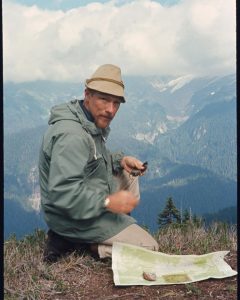
Wonderful to see and hear Gary Snyder in a very recent 25 minute conversation with Wang Ping and towards the end with Steve Dickison at Snyder’s North California home he called Kit Kitdizzee. He’s mellowed, quite understandably as he’s in his 90s now. How I wish he had been President of the USA all these years. No more wars, pollution, corruption, corporate chicanery, we’d have clean rivers, mountains without end. Some ecological and environmental sanity. Have a look at the film, it’s on Youtube now.. He remembers Robert Duncan, Michael McClure, Nanao Sakaki, Kenneth Rexroth, his old friends from the East Jack Kerouac and Allen Ginsberg. Charles Olson too. Gary is a USA National treasure. Go to https://www.youtube.com/watch?v=Y29o2l2iRJ8
—————————————————————————————————————–
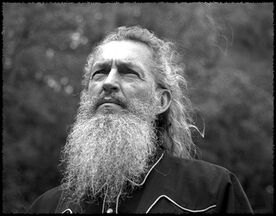
It has been a year hasn’t it. Sometimes it feels like a silent siege, a foe that vanishes in a mist. But it seems like an especially trying year for Ron Whitehead of Kentucky. Ron has contributed a number of articles and interviews to Beat Scene over the years. I’ve still got a photo of a young fresh faced Ron in the same room as Hunter Thompson – and there is a gun involved. And Ron got out alive. In a round robin sort of email just today I read of Ron’s life these past twelve months. Cancer on the side of his head, (operated on and sorted, says Ron) – a heart attack, travels around America for various poetry readings, Ron is a stirring live poet and he’s just been voted in as AMERICA’S BEAT POET LAUREATE. Wow. Ron Well done. The nice guys win sometimes..
———————————————————————–
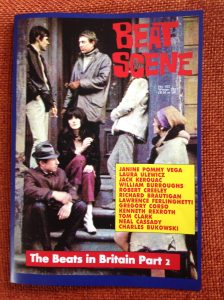
BEAT SCENE 102 is OUT NOW. It is the second volume of THE BEATS IN BRITAIN. The first appeared in 2014. The intention was to quickly issue another of the same ilk, such was the mass of material that had to be left out. ‘Quickly’ became seven years – as life and other publishing demands overtook things, as they invariably do. In amongst Jack Kerouac, William Burroughs, Allen Ginsberg and Charles Bukowski (stop shouting ‘he’s not a beat! at the back there,) there is Tom Clark, Robert Creeley, Richard Brautigan, Gregory Corso, Janine Pommy Vega, Laura Ulewicz, Lawrence Ferlinghetti, Neal Cassady and Kenneth Rexroth. It adds up, the hope is, to something completely different, as Beat Scene continues to try and chart the curve of the Beat Generation’s lifeline from this British (English) perspective. If you would like to order a copy get in touch at kevbeatscene@gmail.com
—————————————————————————————————–
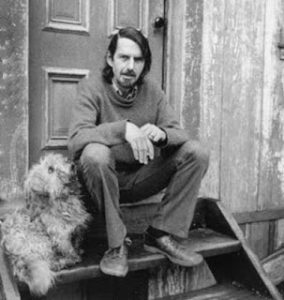 As the chap who steps out of the shed on British TV’s THE FAST SHOW used to say ‘This week we have mostly been …..’ Well here it’s been mostly putting together stories about Robert Creeley and Richard Brautigan, with a big dollop of Kenneth Rexroth thrown in in preparation for Beat Scene 102, which will be a second volume of ‘The Beats in Britain.’ Alongside that trio will be Jack Kerouac, William Burroughs, Laura Ulewicz and more besides. Coming quite soon. With regard to Kenneth Rexroth, things went along to connections with English writers Derek Savage and George Woodcock. Here’s what the English daily The Guardian had to say about Savage back in 2007. That’s Robert Creeley above. https://www.theguardian.com/news/2007/nov/21/guardianobituaries.booksobituaries
As the chap who steps out of the shed on British TV’s THE FAST SHOW used to say ‘This week we have mostly been …..’ Well here it’s been mostly putting together stories about Robert Creeley and Richard Brautigan, with a big dollop of Kenneth Rexroth thrown in in preparation for Beat Scene 102, which will be a second volume of ‘The Beats in Britain.’ Alongside that trio will be Jack Kerouac, William Burroughs, Laura Ulewicz and more besides. Coming quite soon. With regard to Kenneth Rexroth, things went along to connections with English writers Derek Savage and George Woodcock. Here’s what the English daily The Guardian had to say about Savage back in 2007. That’s Robert Creeley above. https://www.theguardian.com/news/2007/nov/21/guardianobituaries.booksobituaries
A few years ago Iain Sinclair agreed on seeing KITKITDIZZE…SEEING GARY SNYDER issued as part of the Beat Scene Press chapbook series. It stemmed from a visit Iain made to Gary’s remote home in Northern California. Snyder is a longtime big favourite around here, as is Iain Sinclair. So, it was a double bonus to publish the chapbook in the regular series format of 8″ x 5″ with cover flaps. An edition of 150 numbered copies. And to have a young ‘Dharma Bums’ era photo of Gary on the cover. Copies are signed by Iain. There are a number of Iain Sinclair penned chapbooks in this series, besides the Gary Snyder, there are William Burroughs, Charles Olson, work taken from his marvelous book AMERICAN SMOKE + a chapbook from his friend Alan Moore all about their friendship – A FUNNY KIND OF RELATIONSHIP – and Jeff Johnson’s CITE SCOUT FOR THE TERRITORY – all about compiling three volumes of Iain Sinclair’s bibliography (the first two now published are monumental). And of course the most recent chapbook in the series GOLD MACHINE BEATS by Iain.
—————————————————————————–
KEEPING THE BEAT
[from the English publication The Times Literary Supplement]
For nearly thirty years, the magazine Beat Scene has celebrated the Beat Generation. The editor and founder, Kevin Ring, is based not in Lowell, Massachusetts, or Bolinas, California, but in Coventry. He is currently planning the journal’s eightieth issue. The latest, No 79, has an article on Jack Kerouac, “The Sounds of the Universe Coming through His Window” – that sort of title appeals to Beat folk – an interview with his ex-girlfriend and recent biographer Joyce Johnson, another interview with a girlfriend of Gregory Corso, and articles on Kenneth Rexroth and LeRoi Jones. Beat Scene’s regular essayist, Jim Burns, looks at the book from which the present journal takes its name, The Beat Scene (1960), edited by Elias Wilentz. There is, as usual, something on Gary Snyder, still living in the backwoods of Northern California, aged eighty-five. Without an actual book to review, Mr. Ring reprints and discusses the press release for Snyder’s forthcoming collection of nature writings, The Great Clod. When asked what has kept him going all this time, Mr. Ring answered, “Coverage of the Beats is still patchy and often not positive. And I like the idea of being English and writing about the Beats.” It has become a mission, he says, “low key, maybe, but a mission. It’s got to be fun. I don’t want the academics to steal the show and rewrite history.” That aspect of the scene – the Academy of Incomprehensibility – dismays him. “I’ve got a job on there.” He is in contact with the enduring Beat writers (not all of whom appreciate the label). “I admire Lawrence Ferlinghetti a lot, the way he has run City Lights Books since 1953 and remained a poet.” Ferlinghetti encouraged Beat Scene in its early years “with letters and postcards and poems.” The other principals are Michael McClure – “it’s a political thing with him: poetry with a purpose” – and Snyder. These three represent what Mr. Ring calls “the ecological wing of the Beat Generation” and are its chief standard bearers today. We asked for the definition of a Beat writer. “There isn’t one,” he replied. “Allen Ginsberg was the arch promoter. Kerouac at times willingly bought into it. But how can you compare Charles Bukowski with John Wieners, Rexroth with Brautigan, Burroughs with McClure? To me the term is a big umbrella under which you can shelter all the different writers, musicians, artists that might be somehow seen as Beat. Like a big family tree.”
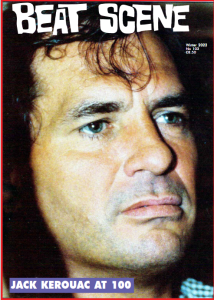
James Campbell writing in the Times Literary Supplement December 11, 2015
Now working on issue 103, that will be JACK KEROUAC AT 100. It makes me smile to be described as ‘Mr. Ring.’ It’s just like being back in the classroom and marking the homework books all over again. Time has taken its toll of course, so many departed in the years since Jim wrote this little article, Ferlinghetti, McClure, ruth weiss, (she always stipulated her name in lower case), Hirschman, Meltzer, Clark, Kyger, Fagin, Fante, di Prima. And yet they live on in their works and all the time their archives reveal more. Jim Campbell no longer writes for the TLS, but tells me he has a book out soon. That book, THE BEAT SCENE, edited by Elias Wilentz – who also with his brother ran a brilliant bookstore in NY which was an unofficial Post Office box address for itinerant Beats way back 1950s – which partly inspired the beginnings of Beat Scene, pictured above. And Beat Scene 79, of which Jim Campbell writes, is also pictured here. Plus, at the top, a picture of that 8th St. Bookstore. https://ephemeralnewyork.wordpress.com/2019/05/27/why-everyone-went-to-the-8th-street-bookshop/
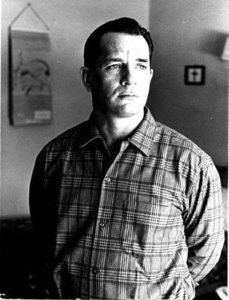 A very early Beat Scene Press chapbook. No 4 in the series from March 2006. JACK KEROUAC IN SAN FRANCISCO by Tom Clark. These two are dummy copies that weren’t for sale back then. They are now. Tom agreed to let some notes in preparation for his biography of Jack Kerouac be published in this format. Carolyn Cassady told me in a letter that it was her favourite biography of Jack. Certainly Tom wrote it with a poet’s eye and ear. If you haven’t read it I recommend you do. Tom also penned biographies of Charles Olson and his pal Ed Dorn. Tom and Ed were together at Esssex University in England in the early 1960s, no doubt shaking up the staid English department there. It was during this time a very young Clark became the poetry editor of THE PARIS REVIEW, it opened the door to many of the poets included in Donald Allen’s THE NEW AMERICAN POETRY being in that journal, Ginsberg, Gary Snyder, Michael McClure, Kerouac et al. Just to point out, both copies here are the same colour, my iPad has played tricks with it. Technology eh. If anyone is interested in a copy let me know by email at kevbeatscene@gmail.com. The original run sold out many moons ago. These two are in fine condition, having been in a drawer for the past sixteen years.
A very early Beat Scene Press chapbook. No 4 in the series from March 2006. JACK KEROUAC IN SAN FRANCISCO by Tom Clark. These two are dummy copies that weren’t for sale back then. They are now. Tom agreed to let some notes in preparation for his biography of Jack Kerouac be published in this format. Carolyn Cassady told me in a letter that it was her favourite biography of Jack. Certainly Tom wrote it with a poet’s eye and ear. If you haven’t read it I recommend you do. Tom also penned biographies of Charles Olson and his pal Ed Dorn. Tom and Ed were together at Esssex University in England in the early 1960s, no doubt shaking up the staid English department there. It was during this time a very young Clark became the poetry editor of THE PARIS REVIEW, it opened the door to many of the poets included in Donald Allen’s THE NEW AMERICAN POETRY being in that journal, Ginsberg, Gary Snyder, Michael McClure, Kerouac et al. Just to point out, both copies here are the same colour, my iPad has played tricks with it. Technology eh. If anyone is interested in a copy let me know by email at kevbeatscene@gmail.com. The original run sold out many moons ago. These two are in fine condition, having been in a drawer for the past sixteen years.
———————————————————–
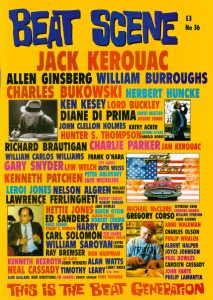 A handful in a box. Beat Scene 36. Dating from 1996. Found today during a ‘tidy up.’ A multi coloured cover. The issue includes Albert Halper, one of Kerouac’s youthful favourite writers, an interview with Philip Whalen, Jack Kerouac, John Fante, William Burroughs, Harry Crews, Joyce Johnson, Charles Bukowski, Kenneth Patchen, Miriam Patchen, John Clellon Holmes. Grab a copy in the UK for £4.50 including postage. Contact kevbeatscene@gmail.com
A handful in a box. Beat Scene 36. Dating from 1996. Found today during a ‘tidy up.’ A multi coloured cover. The issue includes Albert Halper, one of Kerouac’s youthful favourite writers, an interview with Philip Whalen, Jack Kerouac, John Fante, William Burroughs, Harry Crews, Joyce Johnson, Charles Bukowski, Kenneth Patchen, Miriam Patchen, John Clellon Holmes. Grab a copy in the UK for £4.50 including postage. Contact kevbeatscene@gmail.com
—————————————————————————-
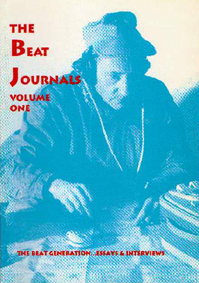 Twenty six years ago in 1995 – The Beat Scene Press issued one of a handful of paperbacks inspired, perhaps, by the work of Arthur and Kit Knight and their terrific series of books about America’s ‘Beat Generation.’ You might recall they went under the moniker of The Unspeakable Visions of the Individual or TUVOTI for short. Borrowed from one Jack Kerouac. The Beat Journals: The Beat Generation – Essays & Interviews featured twenty two articles. That cover image of William Burroughs is a favourite of mine. It might be useful to name those articles here – it kicked off with Michael Robert Gordon’s Jack Kerouac Hides In The Grass. It was followed by Young Jack Kerouac by yours truly. Jim Burns came in with Beat Women. That was a timely essay. There was an interview with William Burroughs which he did especially for an issue of Beat Scene. Robert Drover’s essay on Ken Kesey was also included. Another interview followed, this time with Ed Sanders. Charles Plymell contributed memoirs about Neal Cassady. There was an essay on Charles Bukowski The Misery of Everyday Life. Ann Charters was interviewed. A fine interview with Philip Whalen from Winston Smith. More Bukowski really – an interview with Black Sparrow Press man John Martin. An interview with Herbert Huncke. And another with Jack Micheline. Anne Waldman gave us her Jack Kerouac Dream. Onetime City Lights store manager Dick McBride related a phone conversation he had with an emotional Jack Kerouac. There was a rare talk with Gary Snyder’s sister Thea about her time with Gary and Jack. Angels Still Falling is both a stage play and a screenplay about Jack Kerouac by London writer Richard Deakin, this volume included an excerpt. Jack Kerouac’s Rucksack – another close encounter from yours truly from a time in Lowell. There was poetry from Jack Micheline and Ted Joans rounded off the contents with a letter. I tell you all this because the last copy was sold today. Twenty six years after publication. It was a decent collection, never getting close to Arthur and Kit Knight’s works but useful all the same in hindsight. There will be another completely new volume before too long.
Twenty six years ago in 1995 – The Beat Scene Press issued one of a handful of paperbacks inspired, perhaps, by the work of Arthur and Kit Knight and their terrific series of books about America’s ‘Beat Generation.’ You might recall they went under the moniker of The Unspeakable Visions of the Individual or TUVOTI for short. Borrowed from one Jack Kerouac. The Beat Journals: The Beat Generation – Essays & Interviews featured twenty two articles. That cover image of William Burroughs is a favourite of mine. It might be useful to name those articles here – it kicked off with Michael Robert Gordon’s Jack Kerouac Hides In The Grass. It was followed by Young Jack Kerouac by yours truly. Jim Burns came in with Beat Women. That was a timely essay. There was an interview with William Burroughs which he did especially for an issue of Beat Scene. Robert Drover’s essay on Ken Kesey was also included. Another interview followed, this time with Ed Sanders. Charles Plymell contributed memoirs about Neal Cassady. There was an essay on Charles Bukowski The Misery of Everyday Life. Ann Charters was interviewed. A fine interview with Philip Whalen from Winston Smith. More Bukowski really – an interview with Black Sparrow Press man John Martin. An interview with Herbert Huncke. And another with Jack Micheline. Anne Waldman gave us her Jack Kerouac Dream. Onetime City Lights store manager Dick McBride related a phone conversation he had with an emotional Jack Kerouac. There was a rare talk with Gary Snyder’s sister Thea about her time with Gary and Jack. Angels Still Falling is both a stage play and a screenplay about Jack Kerouac by London writer Richard Deakin, this volume included an excerpt. Jack Kerouac’s Rucksack – another close encounter from yours truly from a time in Lowell. There was poetry from Jack Micheline and Ted Joans rounded off the contents with a letter. I tell you all this because the last copy was sold today. Twenty six years after publication. It was a decent collection, never getting close to Arthur and Kit Knight’s works but useful all the same in hindsight. There will be another completely new volume before too long.
———————————————-
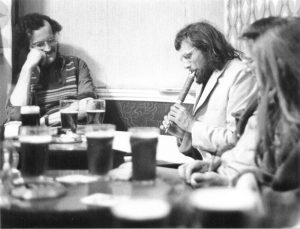
Chris Torrance – the poet who had long lived in rural Wales has just died. His good friend Iain Sinclair said once that he lived a few fields from tarmac. He was 80. Greatly influenced by Charles Olson and Robert Duncan, indeed many of the Beat Poets, Lew Welch included. A photo of him here from the mid 1970s blowing a tune. Writing in The Guardian, a noted English daily newspaper a few years ago, journalist Billy Mills said – “Written episodically over the past 35 years, Chris Torrance’s exploration of myth and landscape in prose and verse is a buried treasure. The Magic Door is the overall title of an ongoing long sequence in prose and verse by Chris Torrance, a Scottish born, London-reared, resident of Wales, and is a work very much in the tradition of Ezra Pound, David Jones, Charles Olson, and the Beats.
This is one of those very interesting works that have been quite systematically written out of the official view of contemporary British poetry. If Torrance was American, he would be a cult figure. But he’s British and almost totally neglected”.
——————————————————————–
Later. Tuesday September 7, on a walk with M.Ring in the local woods across the road, it was silent in there – as it often is. The trees providing plenty of shade. Really a good place to be. We walk a mile or two, there is nobody else around. We come to a bench and think it is a pleasant spot to sit and just be – look at the blue sky, listen to the faint sounds of nature, take in some deep breaths. There at the end of the bench is a hand painted plaster, it seems to me, image about 5 or 6 inches square – forgive me, I’ve never really gone metric. Someone has created an arched doorway. The colours are vibrant. And I’m thinking – that’s got to be a sign from Chris Torrance – it’s his ‘Magic Door.’ Readers of Chris Torrance will recognise his big book of the same name, a work that had been in progress for decades and then finally published by Will Shutes through his Test Centre Press in Norwich. A couple of days before Chris is cremated down near Aberdare there’s this arched doorway icon type thing – propped up on a bench in a wood. Is it a sign or just some weird, random coincidence? I’m going back tomorrow and will photograph the image in situ.
Friday Sept 10 – Here’s a picture of the Magic Door in the woods this morning. A brief service – non religious – was held at the Llwydcoed chapel near Aberdare for Chris yesterday. His cousin Roger Davies spoke warmly of times with Chris at the cottage in Pontneathvaughan, that followed Boogie Stop Shuffle by Charles Mingus. His friend Clare E. Potter spoke of times with Chris and read a Mervyn Peake poem. Epistrophy by Thelonius Monk followed. Another friend, Ric Hool read words by Robert Tay which gave a glimpse of how Chris lived in the area, the local shop, bottles of wine and how he was a well loved figure in the region. Then Praise Poem to Neith where a recording of Chris reading with musical backing was played. It reminded me in some ways of the kinds of material David Meltzer played with his bands in the 1960s. Another good friend Robert King spoke warmly of his friendship over a long time with Chris. A local man. Things finished with Dexter Gordon and Stairway to the Stars. The torrential rain had stopped. It was good to meet some of the people who saw Chris on a regular basis. Clear to see how the man and his writing touched many people. And also meeting Will Shutes again, the publisher of The Magic Door. And, speaking briefly with a man who had been a student of Chris at Cardiff University way back, Mike Greenhoff. Sensibly wearing a mask.
Monday 20 September. Walking in the local woods again this morning M.Ring spotted that the ‘Magic Door’ was now to be found at the base of a very old tree, having been moved from the bench which was far deeper into the woods. It would have escaped my attention. Has Chris moved on? Is it a sign?
Thursday 30 September. In the woods early. The Chris Torrance ‘Magic Door’ has now gone from the base of the tree, its second home in there. Where to I don’t know. But did see a tiny muntjac deer. Don’t think it spotted us as it seemed to be taking its time. Reading from Gary Snyder’s AXE HANDLES on the rough bench. Seemed appropriate.
———————————————————————
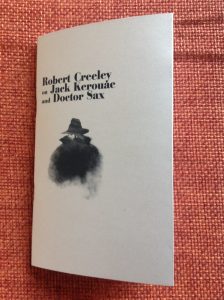
Thanks to the little band of people who pre-ordered ROBERT CREELEY on JACK KEROUAC and DOCTOR SAX, the upcoming Beat Scene chapbook. Number 70 in the series. It’s in the usual series format. A talk given by Robert Creeley a number of years ago, one which needed to be put into print. You know, the old way. Creeley and Kerouac shared that brief mid 1950s time on the West Coast, with the odd letter or two over the next ten years. But that ‘Dharma Bums’ period in Berkeley was crucial for both writers. If you are interested in ordering a copy contact me at kevbeatscene@gmail.com
——————————————
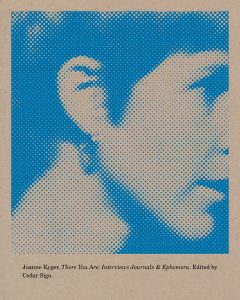
Three or four years ago now we featured THERE YOU ARE, a collection of journals, poems, fragments, photos, letters from Joanne Kyger in Beat Scene. A fine poet. The publishers Wave Press have also published substantial books of the writings of John Wieners and Philip Lamantia, amongst so many others. Here’s a little promotional film they have on their site to illustrate that Joanne Kyger collection. https://www.wavepoetry.com/collections/books/products/there-you-are-interviews-journals-and-ephemera
—————————————————————————————–
 Jack Kerouac fans might be interested in this new, brief film from the Special Collections department of the New York Public Library (The Berg Collection) where one of his notebooks is looked at. Kerouac, as we have all come to know, was meticulous about his many notebooks. They gave him the basis, the foundations for much of his published work. Here’s a link to that little film which displays a Kerouac notebook from 1950. And….then it was gone. Now apparently the film is gone, marked as ‘private’ so us fans are not allowed to see one of Jack’s notebooks anymore. What’s the point of the Berg Collection if readers of Jack Kerouac are not let in to see it – on film? Is it just for the white glove brigade then? Here instead, above, a page from a 1949 notebook..
Jack Kerouac fans might be interested in this new, brief film from the Special Collections department of the New York Public Library (The Berg Collection) where one of his notebooks is looked at. Kerouac, as we have all come to know, was meticulous about his many notebooks. They gave him the basis, the foundations for much of his published work. Here’s a link to that little film which displays a Kerouac notebook from 1950. And….then it was gone. Now apparently the film is gone, marked as ‘private’ so us fans are not allowed to see one of Jack’s notebooks anymore. What’s the point of the Berg Collection if readers of Jack Kerouac are not let in to see it – on film? Is it just for the white glove brigade then? Here instead, above, a page from a 1949 notebook..
——————————————————————
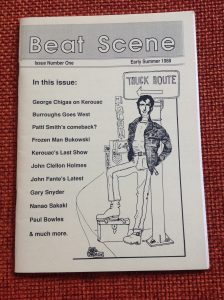 It was March 1988 that the first issue of Beat Scene was published. What’s that, thirty three years ago. How time fades away so quickly when you’re not looking. The first five issues were smaller format. Printed at a local firm by Diane and Susanne and stapled by me on the kitchen table. About two hundred and fifty copies. Andy Darlington, who published his own magazine LUDD’S MILL, supplied the cover artwork. Andy’s magazine was something of an inspiration, as was Palantir by Jim Burns. Contents were strong to begin with, it seems to me now. George Chigas on Kerouac, John Clellon Holmes, John Fante, Jim Burns writing about Al Cohn. Frozen man Bukowski, Gary Snyder, ( a review of LEFT OUT IN THE RAIN), Paul Bowles, Patti Smith, Burroughs, Nanao Sakaki. There was a full page advert for MOODY STREET IRREGULARS: A Jack Kerouac Newsletter published by the devoted Joy Walsh. That first issue was quickly followed by number 2. Cover artwork supplied by Carolyn Cassady. Carolyn allowed some letters from Neal Cassady inside. John Fante again, Charlie Parker, Barry Miles had an excerpt from his biography of Allen Ginsberg. John Clellon Holmes again and, well you can see what else is in there. Jokingly I once called them ‘church newsletters,’ and in hindsight they were just that in many respects. They went out largely to Beat devotees. I can’t claim to any in depth or substantial material in those early days, but it grew with time and experience. It was a lot of fun. Hiring an electric Golfball typewriter for the job, my little Olivetti Lettera 22 was not quite up to the task. And Letraset, remember that? You’d run out of a key letter just at the wrong moment. Five issues appeared in a year. The sales grew with each issue. Mostly to fans in England and then, gradually worldwide. Number 6 was the first to be the standard magazine size. Over a hundred issues of Beat Scene later the magazine continues to be devoted to America’s Beat Generation and, as I always say, associated figures. That’s not to mention countless books, broadsides, recordings, even a film, over those ensuing thirty three years. Thank you all, everyone who ever took the time and put their hand in their pocket to order a copy.
It was March 1988 that the first issue of Beat Scene was published. What’s that, thirty three years ago. How time fades away so quickly when you’re not looking. The first five issues were smaller format. Printed at a local firm by Diane and Susanne and stapled by me on the kitchen table. About two hundred and fifty copies. Andy Darlington, who published his own magazine LUDD’S MILL, supplied the cover artwork. Andy’s magazine was something of an inspiration, as was Palantir by Jim Burns. Contents were strong to begin with, it seems to me now. George Chigas on Kerouac, John Clellon Holmes, John Fante, Jim Burns writing about Al Cohn. Frozen man Bukowski, Gary Snyder, ( a review of LEFT OUT IN THE RAIN), Paul Bowles, Patti Smith, Burroughs, Nanao Sakaki. There was a full page advert for MOODY STREET IRREGULARS: A Jack Kerouac Newsletter published by the devoted Joy Walsh. That first issue was quickly followed by number 2. Cover artwork supplied by Carolyn Cassady. Carolyn allowed some letters from Neal Cassady inside. John Fante again, Charlie Parker, Barry Miles had an excerpt from his biography of Allen Ginsberg. John Clellon Holmes again and, well you can see what else is in there. Jokingly I once called them ‘church newsletters,’ and in hindsight they were just that in many respects. They went out largely to Beat devotees. I can’t claim to any in depth or substantial material in those early days, but it grew with time and experience. It was a lot of fun. Hiring an electric Golfball typewriter for the job, my little Olivetti Lettera 22 was not quite up to the task. And Letraset, remember that? You’d run out of a key letter just at the wrong moment. Five issues appeared in a year. The sales grew with each issue. Mostly to fans in England and then, gradually worldwide. Number 6 was the first to be the standard magazine size. Over a hundred issues of Beat Scene later the magazine continues to be devoted to America’s Beat Generation and, as I always say, associated figures. That’s not to mention countless books, broadsides, recordings, even a film, over those ensuing thirty three years. Thank you all, everyone who ever took the time and put their hand in their pocket to order a copy.
———————————————————————-
A few short words from Gary Snyder on Lawrence Ferlinghetti. Gary is simple, precise but warm about his friend. Taken from Gerry Cimino’s BEAT MUSEUM site.
———————————————————————————————–
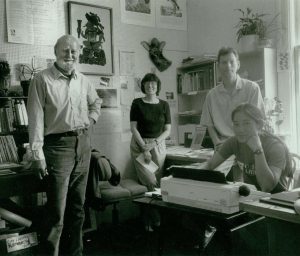
By now most of the media will have some words on Lawrence Ferlinghetti – who has died just short of his 102nd birthday. A fully lived life, where he juggled his creativity through poetry and art alongside maintaining the business of City Lights Books, store and publishing. Not an easy task. You will read his story in many places, though there is only one biography by Barry Silesky and that is decades old. There is Chris Felver’s lovely book of photos, capturing Ferlinghetti in many places. The feeling is that Ferlinghetti didn’t want the attention. He seemed a calm, private man. My only experiences of him, if you can call them that, are a few brief letters from him asking about Beat Scene and ordering copies on a number of issues. He’d usually include a little spontaneous artwork in the letter and he was kind enough to allow one or two poems in my Transit magazine. The only other time was in Brigham’s Ice Cream Parlour in Lowell in 1988. The Jack Kerouac memorial park was being officially opened. Was lucky enough to connect up with the memorial creator Ben Woitena, who was from Texas. A couple of hours sitting with Ben and a couple of milkshakes. Right beside us were Allen Ginsberg and Lawrence Ferlinghetti, we were almost touching knees. They were talking like the very old friends that they were, Ferlinghetti was a young man of about 70 then. Neither Ben or I spoke to them, it seemed bad manners to even think of cutting in. Though we could hear much of what they said. Lawrence Ferlinghetti always had my admiration and always will. He achieved so much and remained true to his ideals. As I said somewhere – he was waiting, now he’s not waiting. Hopefully, in the words of another bloke who’s name escapes me – he’s now safe in Heaven dead.
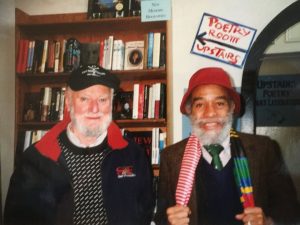 Lawrence Ferlinghetti with Ted Joans
Lawrence Ferlinghetti with Ted Joans
LAWRENCE FERLINGHETTI has died aged 101. Some people talk of eras ending. This might be the case today. He is no longer waiting. The English daily newspaper The Guardian carried this obituary a short while ago. https://www.theguardian.com/books/2021/feb/23/lawrence-ferlinghetti-poet-founder-city-lights-bookshop-dies-aged-101
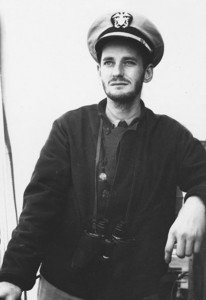 A brief clip of a film from Colin Still’s excellent Optic Nerve site. LAWRENCE FERLINGHETTI reading The World Is A Beautiful Place in the City Lights office. Colin Still has made many films of Beat writers over the years and his site is a treasure trove. https://www.opticnerve.co.uk/poetry/american-poets/lawrence-ferlinghetti/the-world-is-a-beautiful-place
A brief clip of a film from Colin Still’s excellent Optic Nerve site. LAWRENCE FERLINGHETTI reading The World Is A Beautiful Place in the City Lights office. Colin Still has made many films of Beat writers over the years and his site is a treasure trove. https://www.opticnerve.co.uk/poetry/american-poets/lawrence-ferlinghetti/the-world-is-a-beautiful-place
——————————————————————–
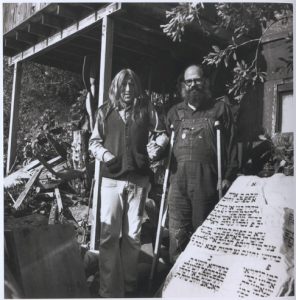 51 years ago Wallace Berman was killed in an car accident. It was his birthday. The Allen Ginsberg Project site recalls this talented man and supreme catalyst with a page or two on his remarkably inspirational life. Film, found sound recordings made at home, Jack Hirschman knocks on his door and comes in. Photos of Berman at work, with Allen Ginsberg. Tosh Berman, son of Wallace and Shirley, reads from his book. And much more besides. Go here – https://allenginsberg.org/2021/02/t-f-18-2/
51 years ago Wallace Berman was killed in an car accident. It was his birthday. The Allen Ginsberg Project site recalls this talented man and supreme catalyst with a page or two on his remarkably inspirational life. Film, found sound recordings made at home, Jack Hirschman knocks on his door and comes in. Photos of Berman at work, with Allen Ginsberg. Tosh Berman, son of Wallace and Shirley, reads from his book. And much more besides. Go here – https://allenginsberg.org/2021/02/t-f-18-2/
————————————————————————————-
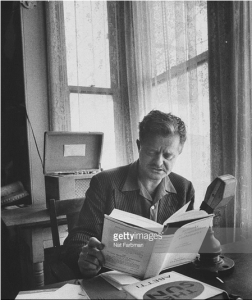 A two hour film celebration of the life and work of Kenneth Rexroth was recorded at Beyond Baroque in recent times. To see this film and get insights into Rexroth and his massive influence on modern American poetics, on literature in general – go here — http://kennethrexroth.com/
A two hour film celebration of the life and work of Kenneth Rexroth was recorded at Beyond Baroque in recent times. To see this film and get insights into Rexroth and his massive influence on modern American poetics, on literature in general – go here — http://kennethrexroth.com/
———————————————————
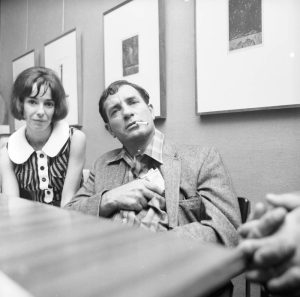
Brief black and white film footage of Jack Kerouac in Milan during his ill fated trip there in the mid 1960s. Fernanda Pivano speaks of his visit in Italian. Jack seems bemused as he is escorted throughs a big bookstore there and is seen sleepily sipping from a glass before eventually dozing off on a sofa. He was, he said, doing the promotional trip there to earn money to care for his sick mother. The film lasts just a couple of minutes. Click here — https://lanostrastoria.ch/entries/x08AooOA1lg?fbclid=IwAR0pfvLPmEEOtyPcEcG42ndlRM3MoZ0XUOotDKkGKT5_IxLW7cGYbtUxSrU
——————————————————————————————————
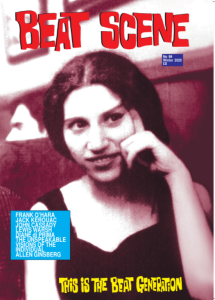 Out now BEAT SCENE issue number 99. In a packed new edition there is close focus on TUVOTI. Older heads will recall this is shorthand for The Unspeakable Visions of the Individual, drawn from Jack Kerouac of course. This was a press run first by Arthur and Glee Knight and later on by Arthur and Kit Knight. Arthur died a few years ago, but not before this man of many talents – along with Kit, saw published a string of books devoted to the Beats, interviews, letters, previously unpublished material, from all of them. They were the kinds of books you’ll never see today, purely because it would be beyond the purse of virtually all publishers to secure rights. And this in the era of 1970s onwards, when quite frankly the Beats were yesterday’s men. Out of print, largely unloved. Arthur wrote to them all, Kerouac, Burroughs, Holmes, Ginsberg, McClure, Snyder. Kit Knight herself has written her memories of what they did. And her essay is preceded by V.J. Eaton’s recollections of their achievements. They were true Beat pioneers. No question. A photo here of Kit Knight with John Clellon Holmes and on the right V.J. Eaton (some of you may have one or two of his Literary Denim books). The picture dates from 1981 at the home of John Clellon Holmes at Old Saybrook.
Out now BEAT SCENE issue number 99. In a packed new edition there is close focus on TUVOTI. Older heads will recall this is shorthand for The Unspeakable Visions of the Individual, drawn from Jack Kerouac of course. This was a press run first by Arthur and Glee Knight and later on by Arthur and Kit Knight. Arthur died a few years ago, but not before this man of many talents – along with Kit, saw published a string of books devoted to the Beats, interviews, letters, previously unpublished material, from all of them. They were the kinds of books you’ll never see today, purely because it would be beyond the purse of virtually all publishers to secure rights. And this in the era of 1970s onwards, when quite frankly the Beats were yesterday’s men. Out of print, largely unloved. Arthur wrote to them all, Kerouac, Burroughs, Holmes, Ginsberg, McClure, Snyder. Kit Knight herself has written her memories of what they did. And her essay is preceded by V.J. Eaton’s recollections of their achievements. They were true Beat pioneers. No question. A photo here of Kit Knight with John Clellon Holmes and on the right V.J. Eaton (some of you may have one or two of his Literary Denim books). The picture dates from 1981 at the home of John Clellon Holmes at Old Saybrook.
——————————————————————
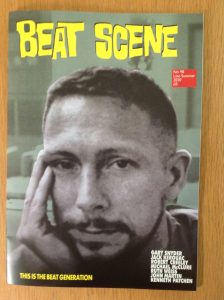 There is a new issue of Beat Scene – number 98. See image of the front cover here. That’s a young Gary Snyder. He also features on the back cover. Naturally Gary features inside, as does Jack Kerouac, Robert Creeley, Ruth Weiss, Philip Whalen, Kenneth Patchen and more. This issue is, once again, ‘Perfect Bound.’ It has a spine. We continue our sharp focus on the Beat Generation and associated figures, with interviews, long essays, photos, histories and up to the minute news (Well as up to the minute as a Quarterly can be). What Beat Scene does, I think, is gather together in one place the Beats – rather than the reader having to search the infinity of online or to have to seek out the obscure places they might appear. It’s a place to turn the page at your own pace. Forget virtual. If you would like to order a copy – please get in touch and email kevbeatscene@gmail.com
There is a new issue of Beat Scene – number 98. See image of the front cover here. That’s a young Gary Snyder. He also features on the back cover. Naturally Gary features inside, as does Jack Kerouac, Robert Creeley, Ruth Weiss, Philip Whalen, Kenneth Patchen and more. This issue is, once again, ‘Perfect Bound.’ It has a spine. We continue our sharp focus on the Beat Generation and associated figures, with interviews, long essays, photos, histories and up to the minute news (Well as up to the minute as a Quarterly can be). What Beat Scene does, I think, is gather together in one place the Beats – rather than the reader having to search the infinity of online or to have to seek out the obscure places they might appear. It’s a place to turn the page at your own pace. Forget virtual. If you would like to order a copy – please get in touch and email kevbeatscene@gmail.com
—————————————————————————————–
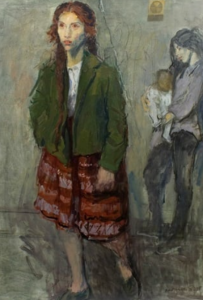
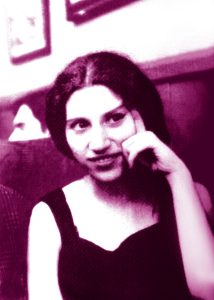
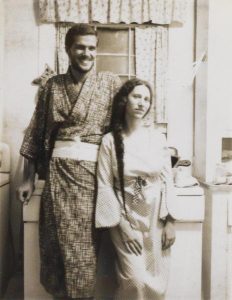
Diane di Prima has died in the past week. She was 86. Here she is with Anne Waldman. It looks a little like the picture was taken at Naropa. Diane had a few stints teaching there. And another couple of her as a young woman. Over the past thirty years or so Diane was always helpful to me. Sending poems for Transit, doing interviews for Beat Scene. She remembered her small press roots. She was, after all, a printer and publisher herself with her Poet’s Press in New York way back. I got to meet Diane twenty years ago in Berkeley and had time for a little conversation. There will be much on Diane in Beat Scene number 99, out before the end of the year.
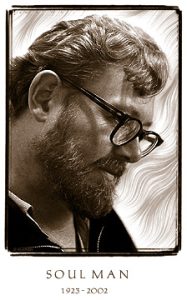
Besides Diane di Prima – Philip Whalen seems to take up quite a lot of reading time here lately. Going back to old books only half (if that) understood and appreciated. Big Bridge https://bigbridge.org/BB19/index.html invariably devote time to Whalen (Warren Coughlin if you read Jack Kerouac). A commendable American poetry site – Brian Unger set up and transcribed some excerpts from 1967 notebooks of Whalen. You’ll find them here. You will see the original Whalen pages and Brian’s transcriptions. https://bigbridge.org/BB15/2011_BB_15_FEATURES/2011_BB_15_WHALEN_FEATURE/bb_15_features_WHALEN_intro.html
————————————————————————————————————-
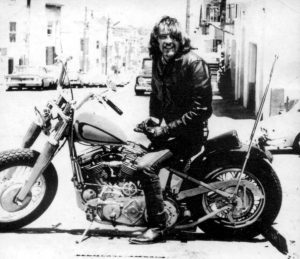
More on MICHAEL McCLURE – his good Oakland friend, poet and broadcaster Jack Foley has done a couple of radio show tributes to Michael on the station KPFA (a lot of history in that place). Jack talks about Michael and the show includes live recordings of Michael reading with Ray Manzarek playing keyboard accompaniment. Go to https://soundcloud.com/john-w-foley/michael-mcclure-tribute-mp3
——————————————————————–
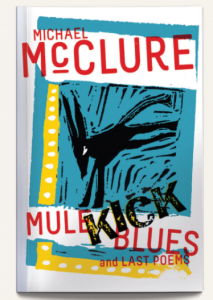 In the period before his death in May this year Michael McClure was working on what was to be his last book. Soon City Lights Books will publish MULEKICK BLUES. I’ve cribbed some of the early reviews from the City Lights site to give you here a feel for what the book might be on release. Here’s Eileen Myles and then Anne Waldman speaking of what they see in McClure’s book………
In the period before his death in May this year Michael McClure was working on what was to be his last book. Soon City Lights Books will publish MULEKICK BLUES. I’ve cribbed some of the early reviews from the City Lights site to give you here a feel for what the book might be on release. Here’s Eileen Myles and then Anne Waldman speaking of what they see in McClure’s book………
“What a beautiful book. He’s Blake-huge and gets away with it, possibly because he’s always in motion. ‘Should I put a hairy tail where my head is?’ He revels in the unstable. The famous all caps that explode in his poems show the bounce of his desire at the micro and macro, a wish to experience, to understand the scale of existence. I’ve never read such a disarming approach to mortality and death, he’s young in it and absolutely with it, most felicitously when he shares it with a friend: “AROUND / THE / EARS / a puff / of / cherry blossom smell” which he repeats to Diane because poets always speak to each other in rhythm. I can’t think of any contemporary artist who explores the interior, the inside-out of the dharma as magically and freely as McClure except maybe for David Lynch. Were they friends? He talks to a shark before crossing to ‘the other side’. The radicality of Michael McClure might be that he’s all on the surface, but rarely alone, like a new kind of depth: ‘To the sensual fly buzzing in my ear / I am a warm good tasting stone.'”—Eileen Myles
“Like Zen poets of yore, Michael McClure’s tender satori consciousness cuts though the Dark Age with friendship, desire, psalms of the meat-wheel, pond-plants physics, and animal cries in spines of symmetry. It’s a pulsing maelstrom. And others chime in: Sung Tung-P’o, Dōgen, Mallarmé, and Blake flex biceps in mutual co-arising. Mule Kick Blues is claps of thunder bringing the mind back to a luminous level of particulars. ‘I’m coming from my hormones with nothing left to tease.’ A cat’s face is ‘like a basket of pine cones in a dream.’ Recently departed, this legendary rockstar eco-poet’s gemlike modal structures will keep humming while ‘black ants circle a bubble of honey.’ A final performance from a master poet.”—Anne Waldman
———————————————————————–
Those very nice people at The Times Literary Supplement recently wrote some kind words about the current issue of Beat Scene magazine, number 97. The one with the Michael McClure image on the front cover. Thank you James Campbell, who I understand penned the article. Much appreciated. Beat Scene of course features many other people besides what I tongue in cheek sometimes tag as the ‘Holy Trinity’ of William Burroughs, Allen Ginsberg and Jack Kerouac. Here’s an image of the TLS words.
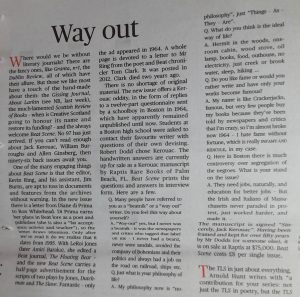
—————————————————————

A new film YOU NEVER HAD IT – all about Charles Bukowski will soon be available. Filmed mostly in 1981 and never released commercially I understand, the footage remained in storage until very recently. A link here to see a clip from the film which is going to be shown at various film festivals. All quite fitting in the year Bukowski would have one hundred years old.
Charles Bukowski Comes to Life in ‘You Never Had It’ Trailer
—————————————————————————————————
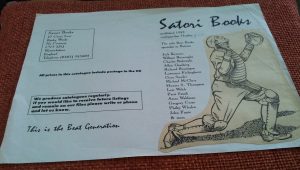 Thanks to Beat Scene friend Peter Hollywood for reminding me of this Satori Books paper catalogue from back in 1987. In the ancient days before the internet took over the world – sending things in the mail was the way. I’d been selling books by and about the Beat Generation since the late 1970s, formalising it with the name Satori Books in 1982. No prizes for guessing where the name arose from. One of Jack Kerouac’s less heralded books of course. This paper catalogue has them all. I marvel at those prices, some of which possibly seemed steep at the time. As I recall it, there were few places you could get ‘Beat’ books in the 1970s and 1980s. Compendium of course in London’s Camden town. God bless Chris Render and Mike Hart & co – Iain Sinclair did paper lists – you’ll see those documented in Jeff Johnson’s monumental bibliographical books on Iain – I’m sure there were one or two others waving the flag too. But they were few. And, judging from a glance inside this catalogue, my desire to publish a magazine was showing itself. That came with BEAT SCENE in 1988. Bits about Kerouac, some words from him on the cover – think that may have been stolen from Moody Street Irregulars – the terrific Kerouac fan magazine from Joy Walsh that played a significant role in reviving Jack Kerouac’s reputation all those years ago. Lawrence Ferlinghetti on the back too. There was a note from Kerouac biographer Ellis Amburn inside – he was a onetime editor of Jack’s too. These were times when I worked as a school teacher and working any other hours at this Beat stuff. Laughing now at what you could do with a few sheets of Letraset (ask your dad) and a portable typewriter. A big advert for Gerald Nicosia’s Memory Babe biography of Kerouac, a page on the excellent The Unspeakable Visions of the Individual books (TUVOTI) put out by Arthur and Kit Knight. It reminded me of trips to Airlift Books near The Barbican in London. People who got Bukowski established in this country, amongst others. Good book distributors and to Dick McBride’s old chapel book warehouse in Buckinghamshire. RIP in Dick. And inside too a short account of going to Bath and meeting up with a lot of other Beat readers to see and hear the revue CITY LIGHTS put on by Jean Wagoner and friends. The hilarious Richard Brautigan sketch is forever in my memory bank. Glad to be reminded of it. Thanks Peter.
Thanks to Beat Scene friend Peter Hollywood for reminding me of this Satori Books paper catalogue from back in 1987. In the ancient days before the internet took over the world – sending things in the mail was the way. I’d been selling books by and about the Beat Generation since the late 1970s, formalising it with the name Satori Books in 1982. No prizes for guessing where the name arose from. One of Jack Kerouac’s less heralded books of course. This paper catalogue has them all. I marvel at those prices, some of which possibly seemed steep at the time. As I recall it, there were few places you could get ‘Beat’ books in the 1970s and 1980s. Compendium of course in London’s Camden town. God bless Chris Render and Mike Hart & co – Iain Sinclair did paper lists – you’ll see those documented in Jeff Johnson’s monumental bibliographical books on Iain – I’m sure there were one or two others waving the flag too. But they were few. And, judging from a glance inside this catalogue, my desire to publish a magazine was showing itself. That came with BEAT SCENE in 1988. Bits about Kerouac, some words from him on the cover – think that may have been stolen from Moody Street Irregulars – the terrific Kerouac fan magazine from Joy Walsh that played a significant role in reviving Jack Kerouac’s reputation all those years ago. Lawrence Ferlinghetti on the back too. There was a note from Kerouac biographer Ellis Amburn inside – he was a onetime editor of Jack’s too. These were times when I worked as a school teacher and working any other hours at this Beat stuff. Laughing now at what you could do with a few sheets of Letraset (ask your dad) and a portable typewriter. A big advert for Gerald Nicosia’s Memory Babe biography of Kerouac, a page on the excellent The Unspeakable Visions of the Individual books (TUVOTI) put out by Arthur and Kit Knight. It reminded me of trips to Airlift Books near The Barbican in London. People who got Bukowski established in this country, amongst others. Good book distributors and to Dick McBride’s old chapel book warehouse in Buckinghamshire. RIP in Dick. And inside too a short account of going to Bath and meeting up with a lot of other Beat readers to see and hear the revue CITY LIGHTS put on by Jean Wagoner and friends. The hilarious Richard Brautigan sketch is forever in my memory bank. Glad to be reminded of it. Thanks Peter.
——————————————————
It was about this time all of 55 years ago that poets Gregory Corso, Lawrence Ferlinghetti and Allen Ginsberg came to London to join forces with a whole roster of British and European poets at London’s Royal Albert Hall. Robert Creeley was supposed to have joined them but never made it. It was an unprecedented poetry gathering for England with thousands attending. The reading got national coverage and was a turning point in the literary landscape of this country. The feeling being that all those who attended realised they were part of something bigger. The event had a unifying impact. In some respects it was the British equivalent of the Six Gallery reading of ten years earlier, where Ginsberg had electrified a much smaller venue with Howl. Poets Gary Snyder, Michael McClure, Philip Lamantia and Philip Whalen were there and played their part also. Here’s a recent article from the London Magazine which reflects on the Albert Hall reading.
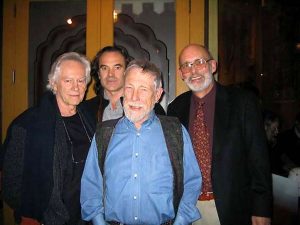 Ahead of Beat Scene 98, where Gary Snyder will feature, I looked at the film made about ten years ago of Gary with the novelist Jim Harrison, THE PRACTICE OF THE WILD. A slowly paced, thoughtful film, centred a lot around a dining room table with various guests. Michael McClure features, as does Gary’s former wife, the late poet Joanne Kyger, along with a significant figure in Gary’s life, the publisher Jack Shoemaker. Gary was just a kid in his late 70s at that point, now 90 of late. Here’s a link to the film on the quality site Vimeo. Thanks to Beat Scene friend Gary Raine for suggesting the link. https://vimeo.com/418682866?fbclid=IwAR2bj_j5CZP0us7uIzD26GZrdjY1p-Y7mJIB37FLF0kEqppijZA2Zwi64V4
Ahead of Beat Scene 98, where Gary Snyder will feature, I looked at the film made about ten years ago of Gary with the novelist Jim Harrison, THE PRACTICE OF THE WILD. A slowly paced, thoughtful film, centred a lot around a dining room table with various guests. Michael McClure features, as does Gary’s former wife, the late poet Joanne Kyger, along with a significant figure in Gary’s life, the publisher Jack Shoemaker. Gary was just a kid in his late 70s at that point, now 90 of late. Here’s a link to the film on the quality site Vimeo. Thanks to Beat Scene friend Gary Raine for suggesting the link. https://vimeo.com/418682866?fbclid=IwAR2bj_j5CZP0us7uIzD26GZrdjY1p-Y7mJIB37FLF0kEqppijZA2Zwi64V4
—————————————————————————————–
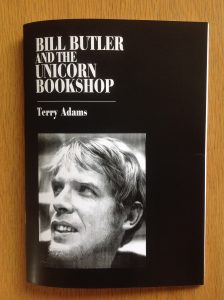 As well as a new issue of Beat Scene magazine, see just below, a new bigger format chapbook is out soon from The Beat Scene Press. BILL BUTLER AND UNICORN BOOKS by Terry Adams, charts the times in the later 1960s and early 1970s when an ex US Marine Bill Butler came to England, worked briefly in the book trade in London and then established the Unicorn bookshop and press in Brighton. Some say the shop was an outreach of Compendium Books in London, so full of Beat Generation, obscure alternative books as it was. Butler, over the years, clashed with the authorities. He also published Bob Dylan, Alex Trocchi, William Burroughs and Jack Kerouac amongst others. Terry Adams tells the story of these years. Available quite soon.
As well as a new issue of Beat Scene magazine, see just below, a new bigger format chapbook is out soon from The Beat Scene Press. BILL BUTLER AND UNICORN BOOKS by Terry Adams, charts the times in the later 1960s and early 1970s when an ex US Marine Bill Butler came to England, worked briefly in the book trade in London and then established the Unicorn bookshop and press in Brighton. Some say the shop was an outreach of Compendium Books in London, so full of Beat Generation, obscure alternative books as it was. Butler, over the years, clashed with the authorities. He also published Bob Dylan, Alex Trocchi, William Burroughs and Jack Kerouac amongst others. Terry Adams tells the story of these years. Available quite soon.
—————————————————————————————————–
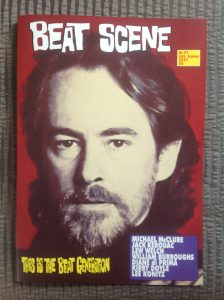 There is a brand new issue of Beat Scene, number 97. As ever, if interested, please email kevbeatscene@gmail.com for further information. Included are Michael McClure, Diane di Prima, Jack Kerouac, Lew Welch, Tom Clark, Charles Olson, Gregory Corso, Kirby Olson, Burroughs and more. This is the first Beat Scene in a ‘perfect bound’ state. With a spine. A big deal for the magazine.
There is a brand new issue of Beat Scene, number 97. As ever, if interested, please email kevbeatscene@gmail.com for further information. Included are Michael McClure, Diane di Prima, Jack Kerouac, Lew Welch, Tom Clark, Charles Olson, Gregory Corso, Kirby Olson, Burroughs and more. This is the first Beat Scene in a ‘perfect bound’ state. With a spine. A big deal for the magazine.
——————————————————
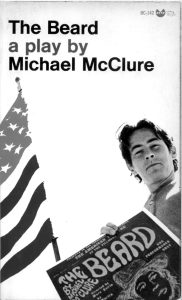 A few lines below about the work of Michael McClure. One from the English alternative music magazine Wire. The other from Jack Kerouac.
A few lines below about the work of Michael McClure. One from the English alternative music magazine Wire. The other from Jack Kerouac.
“…… it’s salutary to hear the voice of Michael McClure, a poet who (for fifty years in print) has explored states of freedom with candor and athletic intelligence. He writes poetry with acute eyes and ears, translating critical observation into precisely tempered verbal notations, celebrating the animal body and human consciousness growing out from it. He’s an expert reader too, with an actor’s voice, sensual and attuned finely to cadence and energies of enunciation. And he’s learned from musicians. As his Beat associate Jack Kerouac might have noted, McClure knows time…”
— WIRE magazine, from a review of the CD I Like your Eyes Liberty
“The most fantastic poem in America…”
— Jack Kerouac (writing about McClure’s long poem Dark Brown)
Some images of poet Michael McClure from the files here. Sadly missed by many. By me. He was a good friend. Despite the many demands on him, he always found time for me. Poet, essayist, performer with Ray Manzarek for many years. Also collaborated with Terry Riley and others. A playwright, with many productions to his credit besides THAT play! (The Beard). The photo of him typing with Frank Reynolds in the background hangs in the hallway here.
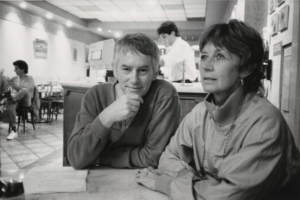
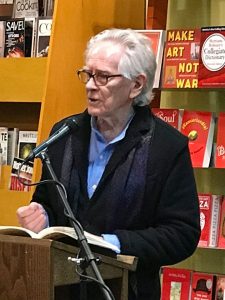
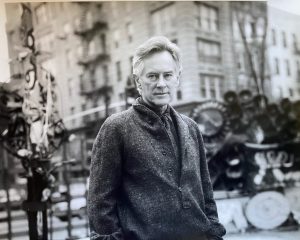
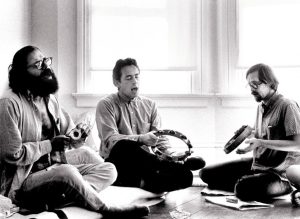
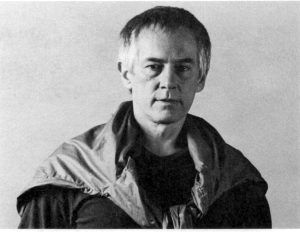
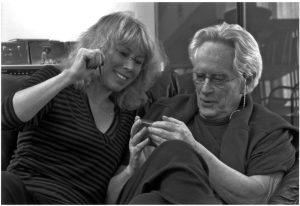
—————————————————————————————-
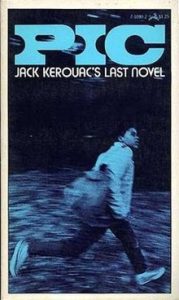
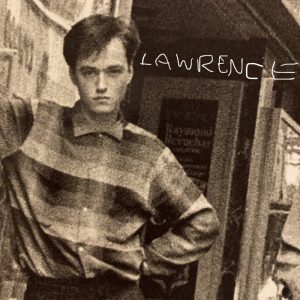 You know when you are searching for something, you can’t put your hands on it to save your life, but other things turn up. Such was the case this morning. Looking in my diary for 1988 for some information that would help a future article for Beat Scene, I found an entry for this month, June of that year. In it I’d entered that I’d spoken with Lawrence of the Birmingham band Felt. I know his surname but he’s protective about it and I won’t mention it. Though it’s possibly common knowledge after all these years. We had quite a long conversation. Think he talked of having his home up for sale, our book passions, Kerouac, music. He’d been over to see me in Coventry a week or two before. A quiet young lad, self effacing. Unique in his own personality. Just a young kid really. Even though I was dealing with something of a migraine I warmed to him right away. His band Felt were pretty popular, hovering on the cusp of real fame. I thought their music was exceptional. Highly melodic, clever, informed. Lots of references, dropped hints. The album at that time was something called THE PICTORIAL JACKSON REVIEW. Lawrence was a big Jack Kerouac fan and it was a kind of tip of the hat from the band to Jack. It was somehow typical that they would pick a novella by Kerouac to shine the light on, a book not always top of any list. But that was Lawrence. If the crowd were going one way, he’d go the other. It was an aspect of him that I liked and respected. He was a good bloke anyway. I think he had Kerouac’s fear of the limelight as well. Unusual in a rock musician. But refreshing. We did make arrangements to go and see the re-screening of the film HEART BEAT in a Birmingham cinema but he wanted to sit on his own. Something about wanting to absorb it by himself. I didn’t mind at all. I like to sit in silence watching films too. Getting drawn into that world. He was deeply into Kerouac back then. I wonder if he still is? At my youngest brother’s (another Loz) house in Sussex a while back I browsed through the big book on Felt that he had on his shelves. It reminded me of that album again. Which I’ll play today. Those guitars. Hope Lawrence is doing ok. He’s had some ups and downs. It’s thirty two years ago. Hard to believe. Quite scary really.
You know when you are searching for something, you can’t put your hands on it to save your life, but other things turn up. Such was the case this morning. Looking in my diary for 1988 for some information that would help a future article for Beat Scene, I found an entry for this month, June of that year. In it I’d entered that I’d spoken with Lawrence of the Birmingham band Felt. I know his surname but he’s protective about it and I won’t mention it. Though it’s possibly common knowledge after all these years. We had quite a long conversation. Think he talked of having his home up for sale, our book passions, Kerouac, music. He’d been over to see me in Coventry a week or two before. A quiet young lad, self effacing. Unique in his own personality. Just a young kid really. Even though I was dealing with something of a migraine I warmed to him right away. His band Felt were pretty popular, hovering on the cusp of real fame. I thought their music was exceptional. Highly melodic, clever, informed. Lots of references, dropped hints. The album at that time was something called THE PICTORIAL JACKSON REVIEW. Lawrence was a big Jack Kerouac fan and it was a kind of tip of the hat from the band to Jack. It was somehow typical that they would pick a novella by Kerouac to shine the light on, a book not always top of any list. But that was Lawrence. If the crowd were going one way, he’d go the other. It was an aspect of him that I liked and respected. He was a good bloke anyway. I think he had Kerouac’s fear of the limelight as well. Unusual in a rock musician. But refreshing. We did make arrangements to go and see the re-screening of the film HEART BEAT in a Birmingham cinema but he wanted to sit on his own. Something about wanting to absorb it by himself. I didn’t mind at all. I like to sit in silence watching films too. Getting drawn into that world. He was deeply into Kerouac back then. I wonder if he still is? At my youngest brother’s (another Loz) house in Sussex a while back I browsed through the big book on Felt that he had on his shelves. It reminded me of that album again. Which I’ll play today. Those guitars. Hope Lawrence is doing ok. He’s had some ups and downs. It’s thirty two years ago. Hard to believe. Quite scary really.
——————————————————————————————

OUT NOW from The Beat Scene Press. A new chapbook in the continuing series. No 69. LOOK AT UNCLE BILL: AN INTERVIEW WITH WILLIAM BURROUGHS. (London 1972). 125 numbered copies in the usual 8″x 5″ format. Thanks to all those who pre-ordered a copy. Yours should be there by now. Anyone else interested please email me at kevbeatscene@gmail.com
Michael McClure dies aged 87
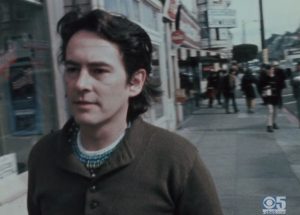
Very sad news yesterday of Michael McClure dying at the age of 87. Even though I was aware that it was a year since he’d suffered a heart attack and a stroke, followed by Sepsis, I hoped he would recover enough to go on. Will recall being with him a number of times, especially one good day at his home, shared with wife Amy, in Oakland. It seemed to me a secluded kind of space. He was kind, gentle natured. Totally dedicated to poetry. Very serious about it. A student of poetic history, aware of the lineage of it all. Proud to be one of that little band of poets at the 6 Gallery reading in 1955 with Gary Snyder, Philip Lamantia, Philip Whalen and Allen Ginsberg. All putting their toes across the line, as I recall him saying of that night. Along with Lawrence Ferlinghetti, Neal Cassady, Kenneth Rexroth and Jack Kerouac, all there together joyously. A string of books over the years. Controversy over his play THE BEARD. Many other plays in his locker. Friend of rock musicians like Janis Joplin and The Doors. Joplin famously recreating his words OH LORD WON’T YOU BUY ME A MERCEDES BENZ. A midlife career in tandem with the brilliant Doors keyboardist Ray Manzarek. Their ACTION PHILOSOPHY is a favourite here. Other collaborations with musicians such as Terry Riley. Plenty of observers have spoken of his poetry and vision of us humans as animals, mammals, all part of some great connectedness. In letters to me he spoke of the birds and other creatures he encountered on hikes near his home. Trips to Africa. His friendship with filmmaker Stan Brakhage way back. Recall him reading in Ledbury in England to a packed hall. He seemed nervous. Told me he had great moments of self doubt. He seemed shy to me. A serious man with a warm smile. I like serious. And he came to England a good few times. The London Review Bookshop readings with Iain Sinclair compering and Colin Still filming. Hushed, attentive crowds. He was a big draw. I hoped these readings here sustained him. And he was generous. Only last year allowing me publication of an essay on Bob Dylan from way back in the mid 1960s. You’ll no doubt have seen those photos by his friend Larry Keenan Jr. of Michael with Allen Ginsberg, Robbie Robertson and Allen Ginsberg in the alley beside City Lights Bookstore. Now renamed Kerouac Alley. He experimented. Who can forget his ‘beast language?’ All part of his take on our place on this planet. He was, along with Gary Snyder, Lawrence Ferlinghetti and others, known as the environmental wing of the Beat Generation. Of course that Beat Generation thing was the work of arch promoter Allen Ginsberg. And Michael McClure, like Gary Snyder, Lawrence Ferlinghetti, transcended that label to go on into the future. He didn’t diminish its importance by any means, instead valued what he felt they had achieved. He was an important poet. I suspect his reputation will grow. For a young student who initially came to San Francisco to study art, he painted quite dazzling exploratory images with his poetry. His physical presence will be sorely missed around these parts but his work will endure. A life lived to the full.
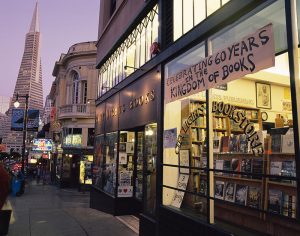 Want to see City Lights Bookstore? Jack Kerouac Alley beside it? Remember Bob Dylan, Michael McClure, Robbie Robertson and a camera shy Lawrence Ferlinghetti gathered in the alley to be photographed by Larry Keenan Jr. in 1965? Go here to have a look courtesy of Google Maps. Just over the street is Jerry Cimino’s Beat Museum. In these days of no travel, it’s a bonus to digitally walk these streets. Thanks to Gary Raine. https://www.google.com/maps/@37.7975374,-122.4065593,3a,75y,278.98h,85.73t/data=!3m6!1e1!3m4!1sZVIRtzMl-Tihi-ctDro2Fw!2e0!7i13312!8i6656
Want to see City Lights Bookstore? Jack Kerouac Alley beside it? Remember Bob Dylan, Michael McClure, Robbie Robertson and a camera shy Lawrence Ferlinghetti gathered in the alley to be photographed by Larry Keenan Jr. in 1965? Go here to have a look courtesy of Google Maps. Just over the street is Jerry Cimino’s Beat Museum. In these days of no travel, it’s a bonus to digitally walk these streets. Thanks to Gary Raine. https://www.google.com/maps/@37.7975374,-122.4065593,3a,75y,278.98h,85.73t/data=!3m6!1e1!3m4!1sZVIRtzMl-Tihi-ctDro2Fw!2e0!7i13312!8i6656
——————————————————————————————————
A link to a short film about an exhibit of the photos of William Burroughs a few years ago at the Photographer’s Gallery in London.
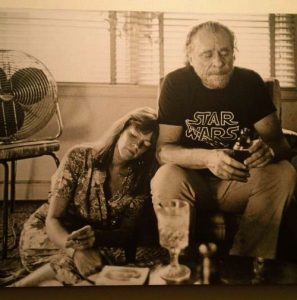
Being this is the year that marks 100 since the birth of Charles Bukowski in 1920 – it seems only right that Black Sparrow Press (the version under the David Godine umbrella) will republish Neeli Cherkovski’s biography of the man. Neeli was a friend, a good friend of Bukowski. They collaborated on a short lived magazine together. Neeli, a well respected San Francisco poet, also published an excellent volume WHITMAN’S WILD CHILDREN which should also surely be ripe for republication. Buk thought that Neeli’s biography went too easy on him, he wanted Neeli to dig deeper, tell the world about how really awful this man Charles Bukowski was – Neeli couldn’t quite do it but his substantial book has got to be a must for anyone at all curious about how this ‘underground’ figure got to be the writer he became. Thanks to Al Berlinski for telling me about this.
————————————————————————————————–
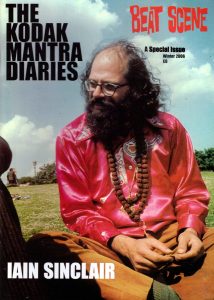 Back in 2006 Beat Scene did a special unnumbered issue which was a revised and extended edition of Iain Sinclair’s THE KODAK MANTRA DIARIES. Originally published by Albion Press in 1971 it had long been quite scarce. We thought Iain’s book about attempting to interview and film Allen Ginsberg in London in the mid 1960s – amongst other things – deserved to find a new audience. The Dialectics of Liberation conference was on at The Roundhouse in London’s Camden Town district. Ginsberg was a big presence at the conference and his discussions, sometimes very heated, with Stokeley Carmiichael were big crowd pleasers. There is a classic photo of Ginsberg, Emmett Grogan and Carmichael in full rant mode in the issue. Included in this new issue were photos of Ginsberg in discussion with Sinclair in the garden of Panna Grady’s house (where Charles Olson was hiding out at). William Burroughs floats in and out. There is Ginsberg out in the parks, talking, being interviewed by a young Iain Sinclair. Running alongside this is the tale of Iain Sinclair and his gang of friends, filmmakers, their struggles to finance things, film as they got to understand the techniques of filming. The setbacks, there was a major setback, but with tenacity Sinclair, in what seems to me a major turning point in his life, grits his teeth and overcomes near disaster to get the film, in glorious 1960s colour, over the line. It’s London, so called ‘Swinging London’, and ‘Ah, Sunflower.’ A beautiful film of its time.
Back in 2006 Beat Scene did a special unnumbered issue which was a revised and extended edition of Iain Sinclair’s THE KODAK MANTRA DIARIES. Originally published by Albion Press in 1971 it had long been quite scarce. We thought Iain’s book about attempting to interview and film Allen Ginsberg in London in the mid 1960s – amongst other things – deserved to find a new audience. The Dialectics of Liberation conference was on at The Roundhouse in London’s Camden Town district. Ginsberg was a big presence at the conference and his discussions, sometimes very heated, with Stokeley Carmiichael were big crowd pleasers. There is a classic photo of Ginsberg, Emmett Grogan and Carmichael in full rant mode in the issue. Included in this new issue were photos of Ginsberg in discussion with Sinclair in the garden of Panna Grady’s house (where Charles Olson was hiding out at). William Burroughs floats in and out. There is Ginsberg out in the parks, talking, being interviewed by a young Iain Sinclair. Running alongside this is the tale of Iain Sinclair and his gang of friends, filmmakers, their struggles to finance things, film as they got to understand the techniques of filming. The setbacks, there was a major setback, but with tenacity Sinclair, in what seems to me a major turning point in his life, grits his teeth and overcomes near disaster to get the film, in glorious 1960s colour, over the line. It’s London, so called ‘Swinging London’, and ‘Ah, Sunflower.’ A beautiful film of its time.
It was a lot of fun to do, with Iain playing his part in getting things right. A learning curve for me.
Ginsberg resplendent in a bright red silk type shirt on the covers, given to him by Paul McCartney. The text was expanded with a new introduction by poet Tom Clark and an afterword from Iain. Lots of new photographs were introduced. The interview with Ginsberg really stands the test of time.
I’m proud of it in a humble way – if that doesn’t sound Double Dutch.
Kevin Ring
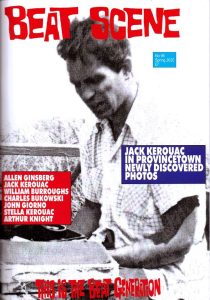 BEAT SCENE number 96 is out shortly. Allen Ginsberg in the early 1970s, Jack Kerouac, Charles Bukowski, William Burroughs, Arthur Knight, John Giorno and more. Orders being taken now. Single copies in the UK are £8. Single copies in Europe are 15 Euros and outside is $20 USA. Includes postage.Please contact by email to kevbeatscene@gmail.com
BEAT SCENE number 96 is out shortly. Allen Ginsberg in the early 1970s, Jack Kerouac, Charles Bukowski, William Burroughs, Arthur Knight, John Giorno and more. Orders being taken now. Single copies in the UK are £8. Single copies in Europe are 15 Euros and outside is $20 USA. Includes postage.Please contact by email to kevbeatscene@gmail.com
IAIN SINCLAIR and GARY SNYDER – TWO BIOREGIONALISTS
Early exploratory notes
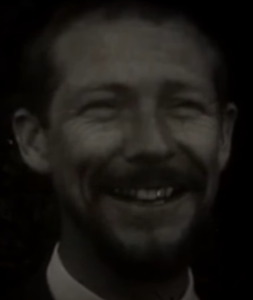 Gary Snyder has often spoken of the idea of ‘bioregionalism’ – if you look back into his collection of essays and interviews – THE REAL WORK: INTERVIEWS & TALKS 1964-1979 (published by New Directions Press back in 1980) you’ll find an interview where he talks with Richard Grossinger, the editor of IO magazine, about this idea of place. The interview took place in 1971 and appeared in Grossinger’s IO, (issue 12) a serious literary magazine of its time (see the Charles Olson issues they published). In this interview Snyder, in my reading of it, appears to tackle the idea or concept of ‘Biogregionalism’ head on. Remember we’ve barely left the 1960s, those years – at least the later 1960s – where the idea of communes, ‘getting back to the country’ were taking firm hold. An era of The Diggers and copycat believers. In my reading of it all Snyder is keen for people to find a place, it often seems rural, pastoral, not always a bucolic idyll and understand that place. To care for it, be in it, immerse yourself, tend it in a benign way, don’t impose on it too much, respect it and live in it. It sounds like a great idea. Ambitious but an aim worth pursuing. Snyder has expanded on his ideas over the next fifty years. Rereading AUSTERLTZ & AFTER: TRACKING SEBALD by Iain Sinclair, published by Test Centre in 2013 reminded me of Snyder’s concept immediately, as so much of Iain Sinclair’s London focused writing does. Sinclair the indomitable walker, going around the boundaries of his Hackney world on a daily basis, that’s on the days when he’s not sailing in a plastic swan boat or venturing to remote Scottish islands or on an overseas trip visiting Post War American poets as in his AMERICAN SMOKE: JOURNEYS TO THE END OF THE LIGHT (published by Hamish Hamilton in 2013) – or even to Peru in the footsteps of his grandfather. Those Hackney and environs walks remind me so much of Snyder’s idea of bioregionalism. Instead of Manzanita and bear Sinclair’s domain includes neglected canals and austerity ridden urban streets. He’s walking the boundaries, seeing what’s up in his neighbourhood. He doesn’t build a home, Kitkitdizze, as Snyder did, yet he’s no less proprietorial about his place than Gary Snyder is about his place in Northern California. His diaries of the state of the place he occupies are as valid as the area Gary Snyder cherishes. In AUSTERLITZ & AFTER:TRACKING SEBALD, Iain Sinclair, in part recalls W.G. Sebald – the name – for me – conjures up English cricketers from about 1930, it’s up there with ‘The Nawab of Pataudi’ who represented Sussex and India as recently as the early 1960s, an era of Fred Truman, Colin Cowdrey, Peter May and others. But initially Sinclair is proceeding along the canal on his morning walk. Part of a body has been discovered in the water. It transpires that it is a soap opera actress. Sinclair notes down his observations and follows the case as it unfolds, he walks alone on these daily trips, a passive observer you might imagine. Yet he’s charting the daily life of his home streets. He’s achieved a measure of ‘success’ with this approach and well merited it is – yet it’s true worth may only be fully appreciated in the decades to come. Such is the accelerating pace of life today that people will uncover his works many decades into the future and rediscover how we lived then. In his own way Sinclair makes his own clarion call for place, digging the powers that be in the shins and the ribs to the state of his nation.
Gary Snyder has often spoken of the idea of ‘bioregionalism’ – if you look back into his collection of essays and interviews – THE REAL WORK: INTERVIEWS & TALKS 1964-1979 (published by New Directions Press back in 1980) you’ll find an interview where he talks with Richard Grossinger, the editor of IO magazine, about this idea of place. The interview took place in 1971 and appeared in Grossinger’s IO, (issue 12) a serious literary magazine of its time (see the Charles Olson issues they published). In this interview Snyder, in my reading of it, appears to tackle the idea or concept of ‘Biogregionalism’ head on. Remember we’ve barely left the 1960s, those years – at least the later 1960s – where the idea of communes, ‘getting back to the country’ were taking firm hold. An era of The Diggers and copycat believers. In my reading of it all Snyder is keen for people to find a place, it often seems rural, pastoral, not always a bucolic idyll and understand that place. To care for it, be in it, immerse yourself, tend it in a benign way, don’t impose on it too much, respect it and live in it. It sounds like a great idea. Ambitious but an aim worth pursuing. Snyder has expanded on his ideas over the next fifty years. Rereading AUSTERLTZ & AFTER: TRACKING SEBALD by Iain Sinclair, published by Test Centre in 2013 reminded me of Snyder’s concept immediately, as so much of Iain Sinclair’s London focused writing does. Sinclair the indomitable walker, going around the boundaries of his Hackney world on a daily basis, that’s on the days when he’s not sailing in a plastic swan boat or venturing to remote Scottish islands or on an overseas trip visiting Post War American poets as in his AMERICAN SMOKE: JOURNEYS TO THE END OF THE LIGHT (published by Hamish Hamilton in 2013) – or even to Peru in the footsteps of his grandfather. Those Hackney and environs walks remind me so much of Snyder’s idea of bioregionalism. Instead of Manzanita and bear Sinclair’s domain includes neglected canals and austerity ridden urban streets. He’s walking the boundaries, seeing what’s up in his neighbourhood. He doesn’t build a home, Kitkitdizze, as Snyder did, yet he’s no less proprietorial about his place than Gary Snyder is about his place in Northern California. His diaries of the state of the place he occupies are as valid as the area Gary Snyder cherishes. In AUSTERLITZ & AFTER:TRACKING SEBALD, Iain Sinclair, in part recalls W.G. Sebald – the name – for me – conjures up English cricketers from about 1930, it’s up there with ‘The Nawab of Pataudi’ who represented Sussex and India as recently as the early 1960s, an era of Fred Truman, Colin Cowdrey, Peter May and others. But initially Sinclair is proceeding along the canal on his morning walk. Part of a body has been discovered in the water. It transpires that it is a soap opera actress. Sinclair notes down his observations and follows the case as it unfolds, he walks alone on these daily trips, a passive observer you might imagine. Yet he’s charting the daily life of his home streets. He’s achieved a measure of ‘success’ with this approach and well merited it is – yet it’s true worth may only be fully appreciated in the decades to come. Such is the accelerating pace of life today that people will uncover his works many decades into the future and rediscover how we lived then. In his own way Sinclair makes his own clarion call for place, digging the powers that be in the shins and the ribs to the state of his nation.

The W.G. Sebald section in the company of friend and co writer Stephen Watts is equally ‘bioregional’ in tone. Watts is steeped in Sebald, they walked together, collaborated in research. You’ll recall Sebald, the Austrian writer domiciled just outside Norwich. A writer of such mysterious and beguiling (to me at least) books as THE RINGS OF SATURN. A man who, like some of the best writers, allowed the sometimes apparently unimportant details, encounters, flotsam, to filter into his works. He saw significance and history where others walked on by. An arch creator of mood, especially melancholy, with room for lateral thought, flights of fancy. But also of the real truth. Not some hand me down reality. Here, in that wider London, Sinclair and Watts chart the sometimes eerie synchronicity of street life. Again, they are both unofficial keepers of their regions.
The two chapters in this Test Centre publication were intended to form part of AMERICAN SMOKE: JOURNEYS TO THE END OF THE LIGHT – but it was felt that, ‘a London detour might be confusing.’ Of course AMERICAN SMOKE concerns itself very much with Post War American writing and culture – as it collides with Iain Sinclair’s own personal history – so taking it out made sense. Of course this unspoken ‘bioregionalism’ of Sinclair’s is evident throughout his London writings. He’s not dispassionate about his environs, far from it. He’s not a carpenter like Snyder, or an expert in plants and fauna, of watercourses, though he knows his canals and he’ll provide anyone who cares to know the history, the vibe and moods of a place. And that, in its own way, is equally as valid when pondering this term of Snyder’s. Watching bodies being fished out of canals and watching the watchers, the people of his region and stepping out in the footsteps of Sebald is as ‘bioregional’ as it gets. Labels evolve. Once Sinclair’s approach was tagged, maybe still is, ‘psychogeography,’ but Iain Sinclair and Gary Snyder share much in their awareness of their respective places. They both, one on America’s West Coast, the other in London’s East End, are ‘bioregionals’ in their own special ways.
To ask about AUSTERLITZ & AFTER: TRACKING SEBALD by Iain Sinclair go to Test Centre run by Will Shutes. www.testcentre.org.uk
Gary Snyder’s THE REAL WORK: INTERVIEWS & TALKS 1964-1979 is published by New Directions Press and is very much still in print.
———————————————————————————————————
Out now – KEROUAC and JAZZ by Jim Burns. Number 68 1n the Beat Scene chapbook series. The regular series format of 8″ x 5″ inches with cover flaps. Really pleased with how it has turned and with the healthy orders for it to date. If interested please contact me on kevbeatscene@gmail.com
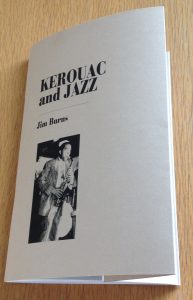
———————————————————————————————-
Beat Scene 96 is well progressed. Lots of variety in an eclectic issue – coming up soon. The current situation has delayed the issue but I’m working on getting it published without compromising anyone’s health and safety. I’d rather throw it away than do that. Plus another bigger format chapbook – a little out of the ordinary but one it is hoped will pique the interest of Beat Generation readers who want to delve deeper. Again, out before too long. While they are imminent I’ve put up here the cover of Beat Scene 68 from 2012. That’s Richard Brautigan on the front, of course, and inside is an interview with William Hjortsberg who had recently seen his mammoth biography of Brautigan published. Highly rated here. Plus Jack Kerouac, Philip Whalen – including an excerpt from a newly published biography of him – another interview, this time with Gordon Ball about being the manager of Allen Ginsberg’s Cherry Valley farm, Paul Bowles and Tangier, Michael McClure, Charles Plymell and Robert Branaman. So, if this sounds up your street – get in touch. kevbeatscene@gmail.com
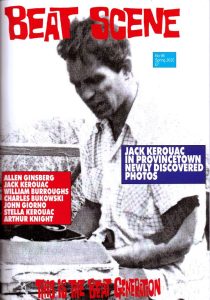
————————————————————————————
A brand new larger than average chapbook – AN EVENING AT BUK’S PLACE: AN INTERVIEW by Jean Francois Duval – is out now. All ordered copies have been posted. Thank you all. A substantial 16,000 word conversation conducted at Bukowski’s home in the mid 1980s. With photos. An edition of 150 numbered copies. Orders being taken now. email me at kevbeatscene@gmail.com
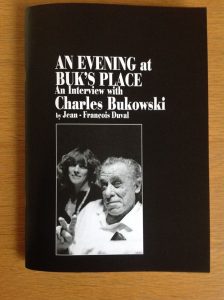
New chapbook soon from the Beat Scene Press – An Evening at Buk’s Place: An Interview with Charles Bukowski by Jean – Francois Duval. A 16,000 word conversation from 1986 – it took place at Bukowski’s house. 150 numbered copies in a slightly larger format than usual. With photos. If this interests you and you would like to pre-order a copy – get in touch at kevbeatscene@gmail.com
———————————————————————————————
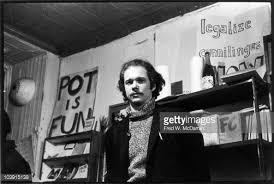 Ed Sanders appears in this BBC Radio 4 documentary – HIPPY INTERNET: THE WHOLE EARTH CATALOG – about Stewart Brand’s Whole Earth Catalog – a pivotal and huge alternative (some would say) publication of the late 1960s and early 1970s that had echoes of the Sears Roebuck catalogue of earlier decades. A guide to a new way of life. I’ve just listened to it after reading a Guardian newspaper review of SMALL TOWN TALK by Barney Hoskyns – all about Bob Dylan, Woodstock, The Band etc. Where it was linked. The show runs for 27 minutes. The documentary was originally broadcast in 2015.
Ed Sanders appears in this BBC Radio 4 documentary – HIPPY INTERNET: THE WHOLE EARTH CATALOG – about Stewart Brand’s Whole Earth Catalog – a pivotal and huge alternative (some would say) publication of the late 1960s and early 1970s that had echoes of the Sears Roebuck catalogue of earlier decades. A guide to a new way of life. I’ve just listened to it after reading a Guardian newspaper review of SMALL TOWN TALK by Barney Hoskyns – all about Bob Dylan, Woodstock, The Band etc. Where it was linked. The show runs for 27 minutes. The documentary was originally broadcast in 2015.
https://www.bbc.co.uk/programmes/p03cp8c2
———————————————————————————————–
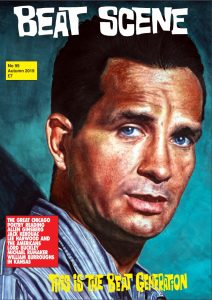
All subscriber copies of the very latest issue of Beat Scene, number 95, have been mailed out. Most will have received their copy by now. A few overseas should receive their copy in a few days. Comments, suggestions, corrections, always welcome. This issue includes Michael Fles on travelling with Ginsberg, Corso and Orlovsky in the depths of freezing Winter to Chicago in the very early 1960s. Also featured are Jack Kerouac’s Trip Trap with Lew Welch and Albert Saijo, not so much a book as an epic journey – through the eyes of Joe Ridgwell, A lost recording of Gregory Corso – salvaged by George Scrivani. Allen Ginsberg on the William Buckley FIRING LINE show and trailing him in Belfast and Swansea eye witness accounts from Peter Hollywood and David Woolley. Plus there’s a feature on the English poet Lee Harwood and his strong links with the American poetry scene of his times. Lewis Warsh provides some insight. Jim Pennington goes on a search for Jajouka and Brion Gysin. Ann Charters recalls the journey her husband Sam had in writing the book SOME POEMS POETS back in the early 1970s, a point at which Beat poets had barely been researched. We can’t have Beat Scene without William Burroughs – there’s an excerpt from the Jake Rabinowitz book BLAME IT ON BLAKE – where Jake recalls his times with Burroughs in Kansas. Plus Robert Frank, Peter Whitehead, Lawrence Feringhetti and obscure cassette releases of his readings and more. As we always say – This Is The Beat Generation. Get in touch at kevbeatscene@gmail.com
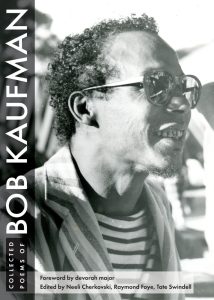
COLLECTED POEMS OF BOB KAUFMAN arrived this past few days from City Lights – with a foreword by Devorah Major, edited by San Francisco poet and biographer Neeli Cherkovski and Raymond Foye & Tate Swindell – it is a substantial collection of some 234 pages with photos included also. Proving that City Lights go from strength to strength and that Bob Kaufman, who was allegedly ‘The Silent One’ for ten years, endures and his reputation remains undiminished. We’ll be featuring this book and Kaufman in general in Beat Scene 96 which will appear later in January 2020.
—————————————————————————————–
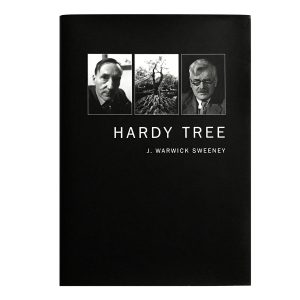 Following on from publication of HARDY TREE (Published by Bracket Press in England) by Warwick Sweeney, which deals with the work of Doctor John Yerbury Dent and in particular the Apomorphine treatment regarding William Burroughs in London in the 1950s, there was a recent radio discussion with Warwick Sweeney, along with Burroughs scholar Jim Pennington, on Resonance Radio. Sweeney discusses the book and the holistic approach John Yerbury Dent employed to gain the best possible outcome. Go here to listen. http://williamenglish.com/hardy-tree/
Following on from publication of HARDY TREE (Published by Bracket Press in England) by Warwick Sweeney, which deals with the work of Doctor John Yerbury Dent and in particular the Apomorphine treatment regarding William Burroughs in London in the 1950s, there was a recent radio discussion with Warwick Sweeney, along with Burroughs scholar Jim Pennington, on Resonance Radio. Sweeney discusses the book and the holistic approach John Yerbury Dent employed to gain the best possible outcome. Go here to listen. http://williamenglish.com/hardy-tree/
—————————————————-
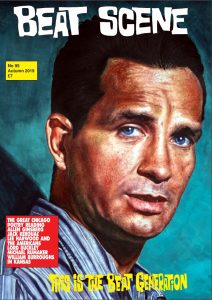 Beat Scene 95 is now available and is being mailed out to subscribers over the next ten days through late November. Here’s a look at the cover featuring the beautiful artwork of Jonathan Collins who recently displayed his Beat inspired art at the Lowell Celebrates Kerouac in his hometown. Anyone interested in pre-ordering a copy get in touch at kevbeatscene@gmail.com – copies are £8 in the UK, 15 Euros in Europe and $20 USA outside Europe
Beat Scene 95 is now available and is being mailed out to subscribers over the next ten days through late November. Here’s a look at the cover featuring the beautiful artwork of Jonathan Collins who recently displayed his Beat inspired art at the Lowell Celebrates Kerouac in his hometown. Anyone interested in pre-ordering a copy get in touch at kevbeatscene@gmail.com – copies are £8 in the UK, 15 Euros in Europe and $20 USA outside Europe
——————————————————————————————–
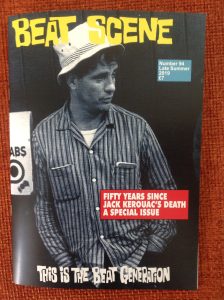 Beat Scene 94 is out now. Here in October. Sure you all recognise the significance of this month in Kerouac’s imagination. It is a special issue devoted entirely to Kerouac and is us marking 50 years since his death back in 1969. All copies have now been posted out. The last batch of 50 went out just today. It is a marginally smaller format and style to the regular issue of Beat Scene. Next issue it will revert to its usual specifications. If you would like to order a copy get in touch at kevbeatscene@gmail.com – prices are £8 in the UK, 15 Euros in Europe and $20 USA everywhere else — including Postage – click here
Beat Scene 94 is out now. Here in October. Sure you all recognise the significance of this month in Kerouac’s imagination. It is a special issue devoted entirely to Kerouac and is us marking 50 years since his death back in 1969. All copies have now been posted out. The last batch of 50 went out just today. It is a marginally smaller format and style to the regular issue of Beat Scene. Next issue it will revert to its usual specifications. If you would like to order a copy get in touch at kevbeatscene@gmail.com – prices are £8 in the UK, 15 Euros in Europe and $20 USA everywhere else — including Postage – click here
——————————————–

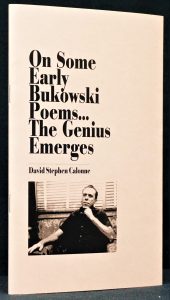 In the long running Beat Scene Press chapbook series – Charles Bukowski – On Some Early Poems – The Genius Emerges by David Stephen Calonne is number 67. 150 numbered copies and in the regular 8″ x 5″ format with foldover covers. OUT NOW. David Calonne is a biographer of Charles Bukowski and an editor of several collections of his early work. Copies in the UK are £8 including postage. Overseas please email kevbeatscene@gmail.com for rates.
In the long running Beat Scene Press chapbook series – Charles Bukowski – On Some Early Poems – The Genius Emerges by David Stephen Calonne is number 67. 150 numbered copies and in the regular 8″ x 5″ format with foldover covers. OUT NOW. David Calonne is a biographer of Charles Bukowski and an editor of several collections of his early work. Copies in the UK are £8 including postage. Overseas please email kevbeatscene@gmail.com for rates.

